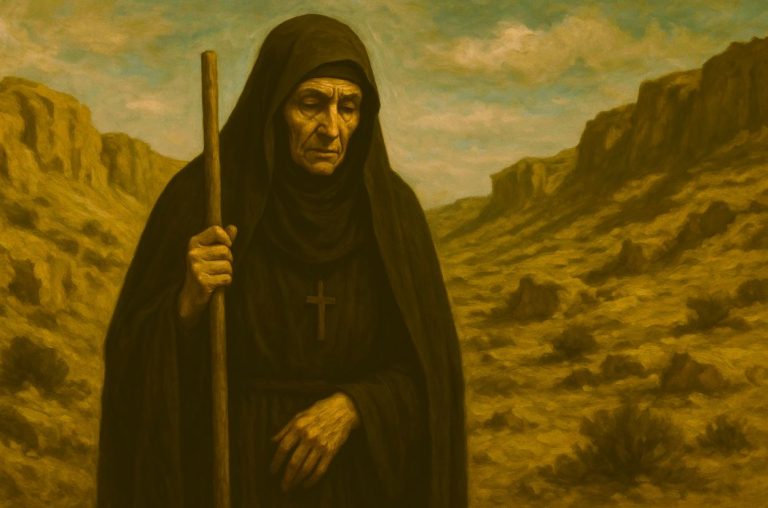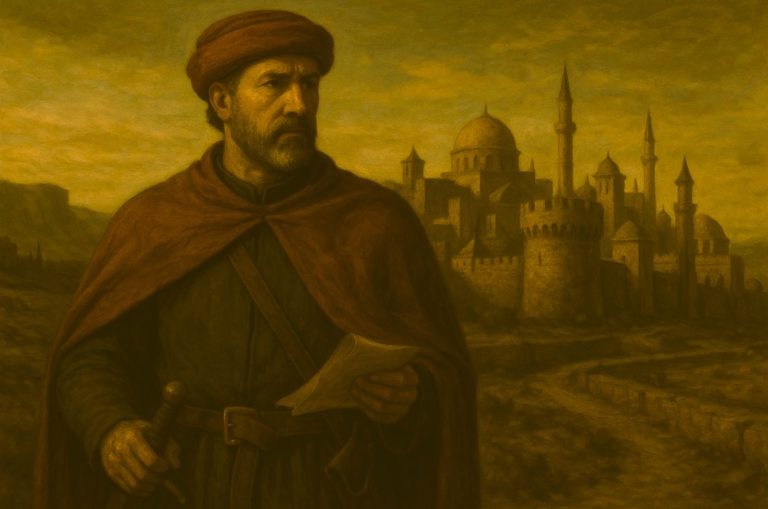
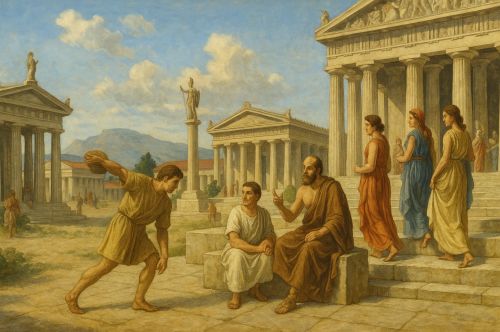
No matter where people settled in Greece, they were rarely more than 50 miles from the sea.

Curated/Reviewed by Matthew A. McIntosh
Public Historian
Brewminate
Geology and Geography
The Greeks called their land Hellas and themselves Hellenes. It was the Romans who called them Greeks- (Graeci ) and that is the name by which we know them.
The Greek historian Herodotus wrote that “Egypt is the gift of the Nile” but he never came up with an expression so memorable to describe his own country. Perhaps that was because the Greece he knew was never a united nation with fixed geographical borders. Rather it was a collection of city-states (although town-state or even village-state would have been more accurate for few had the population to be called a city.) These city-states were like a large family of quarrelsome brothers, almost always fighting with each other, but occasionally, banding together to battle against outsiders when they felt like doing so. Afterwards, they were as likely as not to turn on each other again.
In soft regions are born soft men.
Herodotus
The Greeks have often been described as “independent-minded” and there seems no doubt that geography played a major role in shaping that character. It was the mountains and the sea that molded Greece and Greeks into what they were.
Mountains in Greece don’t soar to the heights of other mountain ranges such as the Andes, Rockies, Alps or Himalayas-but they are extensive. In fact, about 80% of Greece is covered with mountains with the result that most settlements were less than 10 miles from a mountain. These mountain ranges isolated regions from each other more effectively than fences because what they lack in height they make up with steepness and ruggedness preventing or discouraging overland travel and communication.
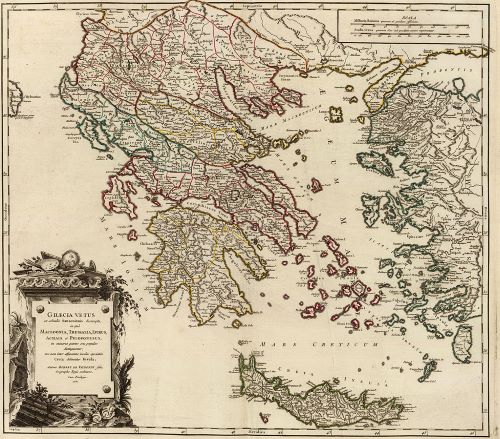
No matter where people settled in Greece, they were rarely more than 50 miles from the sea. The philosopher Plato noted that the Greeks lived around the sea “like frogs around a pond.” A deeply indented coastline held between its rocky fingers a sea that could vary from tranquil to turbulent depending on the season and the weather. Most Greek mariners had experienced firsthand the sea’s treacherous currents and diabolical whirlpools.
During the summer months the sea tended to be peaceful. Being an inland body of water the Mediterranean Sea has almost no tides- less than a meter between high and low tides. It has little plankton (that’s why its waters are so clear), which means that it doesn’t support the extent and variety of sea life seen elsewhere but certainly enough to be both an important and welcome source of food.
Surrounded by water, the Greeks nevertheless faced a shortage of fresh water. Compared to many countries, there is a real scarcity of rivers and these often dry up to a trickle in the hot summer months. (Summer temperatures, because of the cloudless skies, are often hotter than in the Tropics.) The lack of rivers is offset somewhat by a plentiful supply of freshwater springs. These were precious and lifegiving and it is not surprising that they were considered to be sacred sites.
The Minoans
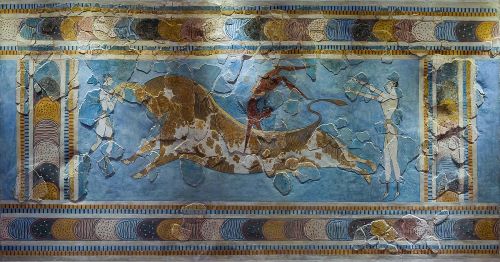
It is virtually impossible to talk about early Greek history without at some point introducing the Minoans. The Minoans were not Greeks nor do they appear to be closely related. What seems clear however is that they helped to shape the early Greek civilization, later immortalized by Homer and other Greek poets.
The Minoans have left a stunning visual legacy (paintings, sophisticated palaces and varied artwork) as well as large quantities of written records. Unfortunately, unlike the writings of the Egyptians, Hittites and Babylonians which shed light on such things as social organization, religious beliefs and historical events, those Minoan writings discovered so far are simply inventory records- detailed, plentiful but not as enlightening as one might hope. An added complication is that scholars have only been able to decipher a small portion of their written language.
What we do know is that the Minoans were gifted artists and that the subject matter of their artworks seems to have been heavily influenced by aesthetic considerations. Some have suggested that they may have loved art for its own sake, which would be an enormous change in the way art was traditionally created and used in other societies at that time. But more research on that possibility is needed.
Based on the evidence currently available, it seems that the Minoans arrived on the large island of Crete more than 5000 years ago. The soil was fertile, the climate was favorable and the numbers of people increased. Eventually a point was reached when the resources of the land were insufficient to meet the needs of the expanding population. Many migrated to nearby islands, those that stayed turned increasingly to trade as a means of improving their economic situation.
Successful and extensive trade resulted in a Minoan society that was wealthy and archaeology suggests that wealth was widely shared throughout the community. The extensive written records that do exist and have been deciphered show a highly controlled flow of goods into and out of state storehouses. The standard of living was high. Within the palace complexes… sophisticated plumbing, wonderful frescoes, plaster reliefs and open courtyards.
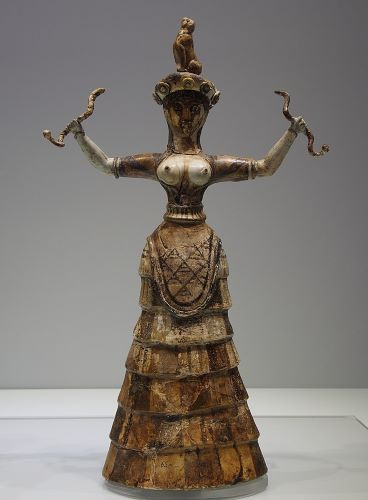
People had leisure time and devoted a good portion of it to sports, religion and the arts. While we can only guess at their religious beliefs, the remains of their artwork suggest a polytheistic framework featuring various goddesses, including a mother deity. The priesthood was also completely female, although the King may have had some religious functions as well. In fact the role of women- as religious leaders, entrepreneurs, traders, craftspeople and athletes far exceeded that of most other societies, including the Greeks.
Their system of government was that of a monarchy supported by a well-organized bureaucracy. According to myth, a King Minos, living in a palace with more than a thousand rooms, once ruled the island of Crete. In 1900 such a palace was discovered, excavated and partially restored by British archaeologist Arthur Evans. It was Evans who coined the term “Minoan civilization” in honor of the legendary King.
Around 1450 BC the Minoan civilization, which appears to have been peaceful and prosperous, came to an abrupt and probably violent end. There is evidence of wholesale destruction by fire and there has long been speculation that a volcanic explosion at Thera (followed possibly by a tsunami) ended this great civilization of the Aegean world. That hypothesis has now been called into question as recent studies of ice core samples push the Thera eruption further into the past.
The Mycenaeans
Around 2000 BC Greek-speaking immigrants moved into the Aegean. Skeletal remains confirm they were tall and well built. The newcomers looked first to the sea for food and later found that the dry and rocky soil was well suited for growing olives and grapes. It seems these people were a war-like lot, ruled by military leaders. In many ways they resembled the Vikings that would plague Europe some 25 centuries later- pirates, raiders and traders- who after a time settled down and became civilized. The term Mycenaean has been given to this civilization, derived from Mycenae, the site first excavated by Heinrich Schliemann after his discovery of fabled Troy.
The Mycenaeans began to trade and have cultural contact with the Minoans. The latter influenced the development of their cities, the production of trade goods and improvements in agriculture. Unlike Minoan cities, which had no or minimal fortifications, the Mycenaean settlements were heavily fortified with colossal perimeter walls. Since they periodically raided and looted towns in Hittite and Egyptian territory the massive fortifications were likely seen as a cost of “doing business”. The art themes depicted on Mycenaean artifacts (scenes of warfare and hunting) make a sharp contrast with the pastoral content of Minoan artwork. Their militaristic approach worked well for the Mycenaeans bringing power and prosperity. Between 1600 and 1200 BC their culture flourished.
Their religious beliefs seem to have been very similar to those of other ancient civilizations of the time and share in two important characteristics- polytheism and syncretism. Polytheism is a belief in many gods and syncretism reflects a willingness to add foreign gods into the belief system-even if the new additions don’t exactly fit. When the Mycenaeans first arrived in the Aegean they likely believed in a pantheon of gods headed by a supreme Sky God common to most Indo-European peoples. His name was Dyeus which in Greek became Zeus. Following contact with the Minoans and their earth goddesses, these goddesses were incorporated into the pantheon and that is likely the path followed by Hera, Artemis and Aphrodite.
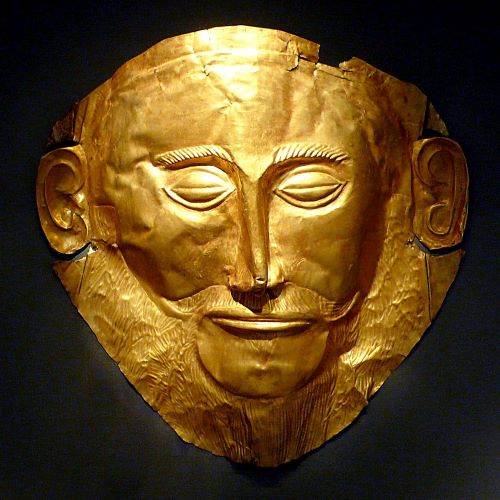
It was the Mycenaeans that Homer immortalized in his two epic poems the Iliad and the Odyssey. The question that is often asked is “How much, if any, of those tales are true?” and the answer is that it is unlikely that that question can be completely answered in our lifetimes, if ever. Myth, history and archaeology – all different – but there are examples where they coincide remarkably, and others where they cannot be made to meet, despite the most earnest coaxing. Homer and his forefathers nursed the Mycenaean legends through the tunnel of the Dark Ages into the light of the later Greek world. How much was dropped off and added on in that journey is the subject of speculation and the stuff of debate. What is evident is that some of the content is clearly true and some is the product of imagination. Sorting one from the other has become a task for the ages.
So what happened to the Mycenaeans? The answer is that sometime around 1200 BC, when the Mycenaean civilization was at its peak, it suddenly appears to have collapsed. Some scholars feel we will never know with certainty what happened and why. There are lots of theories: their history of military violence finally caught up with them; natural disaster in an area plagued with earthquakes and volcanic eruptions; the possibility of drought and famine followed by civil uprising. There is evidence of a lot of migration.
Volcanic Eruption at Thera (Santorini)
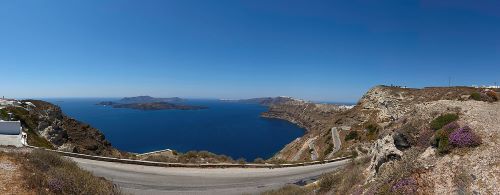
In 1646 BC a massive volcanic eruption, perhaps one of the largest ever witnessed by mankind, took place at Thera (present day Santorini), an island in the Aegean not far from Crete. The explosion, estimated to be about the equivalent of 40 atomic bombs or approximately 100 times more powerful than the eruption at Pompeii, blew out the interior of the island and forever altered its topography. Possibly as many as 20,000 people were killed as a result of the volcanic explosion. Just as happened at Pompeii centuries later, a settlement on Thera known as the town of Akrotiri was buried under a thick blanket of ash and pumice.
For more than 3,500 years the ancient Bronze Age community lay hidden- one of Greece’s many secrets of the past. Then, as is often the case with various heritage sites, the town of Akrotiri was accidentally discovered. Quarry workers, digging out the pumice for use in the manufacture of cement for the Suez Canal, chanced upon some stone walls in the middle of their quarry. These eventually proved to be remains of the long-forgotten town. Archaeologists from France and later from Germany did some preliminary excavation in the second half of the 19th Century but it was not until 1967 that systematic excavation began at the site in earnest. Spyridon Marinatos, supported by the Archaeological Society of Athens, soon began to uncover the remains of the ancient town. It was not easy. Not only were the buried buildings two or even three stories tall, the original building materials (clay and wood) had been damaged by earthquakes, fire and the hands of time. It was necessary to proceed slowly and carefully. Work on the project has now been on-going for almost four decades and it is likely to continue into the foreseeable future.
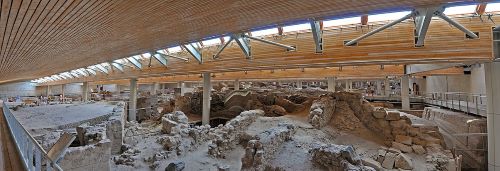
The site has yielded some surprising information. Most startling of all is the fact that no human remains have been found at Akrotiri, unlike Pompeii and Herculaneum where the dead were buried in the midst of their daily activities. At Akrotiri, it was obvious that people had begun to do some repair work to their dwellings, probably in response to minor earthquake or volcanic damage. However, before the major eruption at least some of them had the time to pack up their families and most valuable possessions and leave. Huge pottery containers and large household furnishings were abandoned in their haste to depart but it seems clear that most people got away safely, were buried elsewhere or were swept away by the tsunami waves that might have accompanied such a massive eruption.
The Akrotiri site has not yielded huge amounts of gold, silver and bronze artifacts, nothing on the scale that might have been expected had the inhabitants been caught unawares. But a splendid visual legacy was left, most of it in pieces that are painstakingly being assembled by Christos Doumas and his colleagues. The frescoes at Akrotiri are spectacular, were exceptionally well-preserved by the protective blanket of ash that covered them and their locations can be correlated to various rooms within the town.
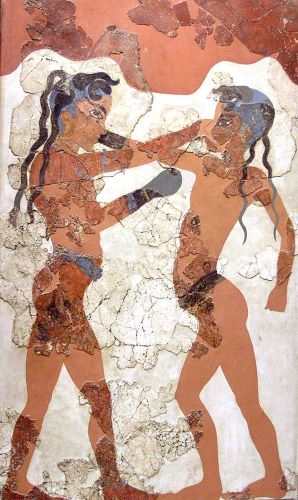
The paintings provide a lot of visual information that needs to be carefully analyzed- a fleet of ships manned by sailors allowing one to see how the vessels were rigged, how the crew was dressed, what they carried by way of tools and weapons; people in the community going about their daily activities, picking flowers, making religious offerings; two nude fishermen carrying strings of fish; young boys in a boxing match, etc.
Historians have been debating for years about exactly when the major eruption at Thera took place. Radio-carbon dating and dendrochronology (tree-ring dating) had narrowed the date down to a range of years but neither could confirm a specific year. Then improvements in the science of ice core dating made it possible to pinpoint a particular year-1646 BC- a century earlier than most historians had thought. (Ice cores drilled out of the Greenland ice cap show seasonal variation in the same manner as tree rings. The winter snow fall creates yearly bands and within that band the atmospheric activity is recorded. The volcanic eruption at Thera was confirmed as happening in 1646. At the present time, the core depth allows scholars to look back in time some 200,000 years and work will continue on making that timeline longer.)
The Golden Age of Greece
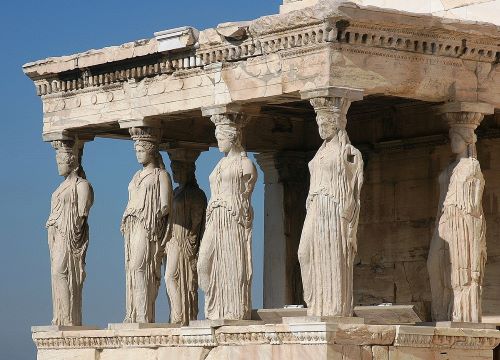
The “golden age” of Greece lasted for little more than a century but it laid the foundations of western civilization. The age began with the unlikely defeat of a vast Persian army by badly outnumbered Greeks and it ended with an inglorious and lengthy war between Athens and Sparta. This era is also referred to as the “Age of Pericles” after the Athenian statesman who directed the affairs of Athens when she was at the height of her glory.
During this period of time significant advances were made in a number of fields including government, art, philosophy, drama and literature. Some of the Greek names most familiar to us lived in this exciting and productive time. It was an era marked by such high and diverse levels of achievement that many classical scholars refer to the phenomenon as “the Greek miracle”. Even those who don’t believe in miracles will concede that it is possible that the ever-competitive Greeks were spurred on to higher levels of innovation in their field by seeing the bar being raised in so many other areas.
None of this would have happened without an encouraging environment and Athens was at that time at the “top of her game”. Her citizens were supremely confident, filled with energy and enthusiasm and utterly convinced that their city provided what a combined London – Paris – New York might offer today.
Military victory over the Persians, largely achieved under Athenian leadership, set the stage. The transition in government from the reluctant hands of the aristocratic elite into the mass of common people also played an important role. More people felt that their opinions mattered than ever before.
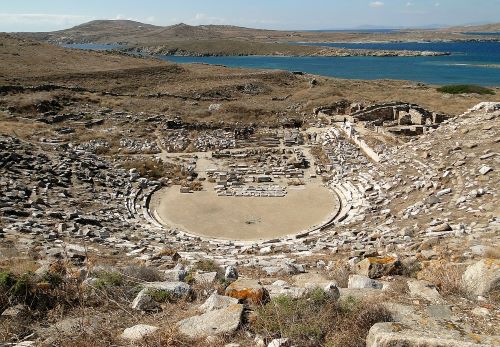
One of the greatest inventions of the ancient Greeks was drama. It evolved out of religious ritual and promptly proved to be both an enduring and popular creation. Greek tragedies, featuring historical and mythological events, were written and directed by authors such as Aeschylus, Sophocles and Euripides. (Many feel that only Shakespeare merits inclusion in their company.) Each won numerous prizes and critical acclaim and each added innovations to the field of drama.
The lyric poet Pindar ushered in the era and became famous in his lifetime for victory odes written to celebrate athletic success. The writers of prose also flourished. Herodotus, regarded as the father of history, wrote several illuminating books on the Persian wars (and is still often consulted source on ancient Egypt). Another war historian, Thucydides, is still admired as a lucid and evocative writer. Plato, whose writings largely survive, is said to have penned the most poetical prose since the Bible.
The golden age gave us Socrates who steered philosophy in the direction of morals, logic and ethics. His life, and the manner of his death, had a massive impact on other major figures of that epoch such as Plato, Aristophanes and Xenophon.
The physician Hippocrates, the sculptor Phideas, the architects of the Parthenon, all contributed to an era that truly deserves to be called “golden”.
What brought the golden age to an end? The long and mutually murderous war between Athens and Sparta, with their conflicting values and aspirations? Military misadventures? Dreams of imperialism? Possibly the best answer lies in what the Greeks call hubris. Perhaps Athens overstepped its bounds and failed to follow the twin admonitions of Delphi- know thyself and All things in moderation. Perhaps, like Icarus, it tried to fly too close to the sun.
The Alphabet and Writing
History
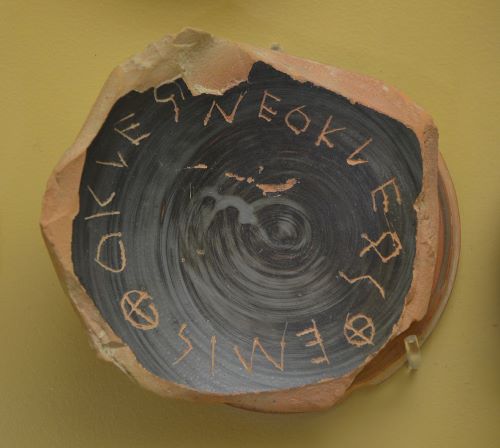
“Whenever Hellenes take anything from non-Hellenes, they eventually carry it to a higher perfection.”
Plato, Epinomis
According to the ancient Greeks they adapted their alphabet from the Phoenicians. Both were great seafaring peoples and eager to trade not only goods but ideas. One of the most important ideas was the alphabet. It enabled a system of writing by which they could record their transactions- 100 jars of olive oil, 20 blocks of white marble, 30 packages of purple dye, etc. As with other ideas they borrowed the Greeks made improvements, increasing the number of letters by adding vowels. This happened sometime around the beginning of the eighth century BC.
This was not the first time that Greek speaking peoples had used a written language. The Mycenaeans, who were the subjects of Homer’s Iliad and Odyssey, had developed a system of writing that today’s scholars call “Linear B”. Several thousand sun-dried clay tablets covered with the Linear B script have been found on the island of Crete. They represent the earliest form of written Greek known. Deciphered by a young English architect (Michael Ventris), the tablets recorded details about the storage and distribution of household goods. The information was probably written around 1400 BC. Then, during the Dark Age, the knowledge of writing died out. The Greeks became an illiterate society.
With the adoption and modification of the Phoenician alphabet the Greeks were on their way to becoming literate again. In fact, the achievements for which they became renowned in fields as varied as philosophy, science, government, literature and medicine would not have happened if it weren’t for writing. Socrates wrote nothing but we know so much about what he thought and said because of the writings of Plato. Access to a simple writing system meant that everyone willing to learn could, in theory, do so –women, slaves, peasants as well as members of the aristocracy. In fact, however, most didn’t, and illiteracy was widespread during the golden age of Greece- the Classical Era.
The Mycenaean Greeks used sharp instruments to engrave their language into wet clay tablets. (A major fire at an ancient palace baked thousands of these tablets and preserved them for scholars today.)
Later Greeks used a variety of writing implements- papyrus (which they got from Phoenician traders), parchment (which was made from the scraped hides of cattle, ship or goats), wooden tablets whitened with gypsum, wooden tablets coated with wax and, of course, more durable materials such as stone monuments and bronze plaques. These more permanent materials were often used for official inscriptions- laws of the city, treaties with other states, temple dedications, war memorials and such.
Early Greek writing runs from right to left- for the first line. The second line then runs from left to right and the direction of the lines alternate for the complete text. This kind of writing is called boustrophedon (as the ox turns- when he plows a field.) Later the left to right system, which we use today, became the standard.
Homer
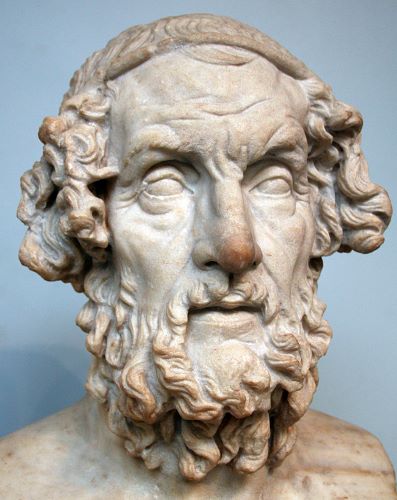
It was Homer (perhaps Homer of Chios) who wrote the two classic works of literature the Iliad and the Odyssey. (Actually, he likely didn’t “write”; it seems more probable that he “dictated” to a man legend identifies as Palamedes.) The way of life that is described in the two epic poems comes mostly from Homer’s own time although the period he describes extends backwards into Mycenaean times. There is still much uncertainty in academic circles about when the poems were written down-perhaps around 775BC – after centuries of being recited or sung. What is clear is that it would not have happened without the invention of the first true alphabet, the first writing that could be pronounced by someone who is not a speaker of that language.
So it is that the Gods do not give all men gifts of grace – neither good looks nor intelligence nor eloquence.
Homer
Although later generations of Greeks lauded Homer as the first and greatest Greek poet, they seemed to know little about the man himself. Various communities claimed that he was born or had lived there but the forensic evidence on the subject is not conclusive. Neither is the claim that he was blind although a well-known bust of the poet suggests that. Both the Iliad and the Odyssey reveal a wealth of information about Greek society and cultural expression during the Dark Age. The description of the bronze armor of Achilles, the evolution of the Greek polis (city-state) and the detailed accounts of battles are all vividly written and visually evocative. They have the ring of truth about them. Although it may not be possible to extract solid historical data from Homer he certainly taught the world how the ancient Greeks thought and felt about themselves.
The difficulty is not so great to die for a friend, as to find a friend worth dying for.
Homer
It is impossible to overemphasize his impact on Greek society. Homer gave his countrymen an expected model of behavior, a handbook of values. Students relied on Homeric texts, orators and politicians quoted him and philosophers and philologists dissected his poems. As more than one person expressed it, “I studied Homer so that I might become a better man.” Admirers included Alexander, the Great who slept with his sword and a copy of Homer by his bedside. The German archaeologist Schliemann would not have discovered (and inadvertently partially destroyed) the ancient city of Troy without the aid of Homer. His status as the greatest epic poet ever is rarely challenged.
Hesiod
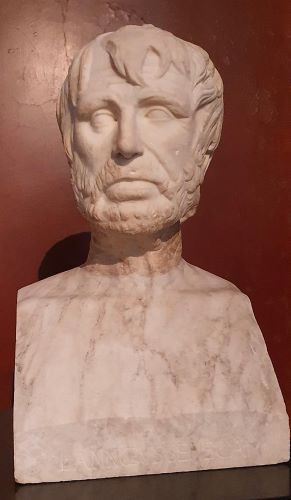
The poet Hesiod lived in the same timeframe as Homer, perhaps around 700 B.C. Most scholars agree that he was born in Boeotia and Hesiod himself in one of his major poems – Works and Days – characterizes his homeland as “a cursed place, cruel in winter, hard in summer, never pleasant”. (According to legend he became involved in a bitter land dispute with his brother which, if true, might have coloured his perspective on the matter.)
Hesiod’s birthplace was at the foot of Mount Helicon and tradition has it that the nine muses lived on the mountain. Hesiod credits them with inspiring his words, of breathing into him “a divine voice to celebrate things that shall be and things that were aforetime.” (Theogeny, lines 31-32)
Hesiod is remembered for two poems in particular- Works and Days and Theogeny. The former is an 800-verse poem that extols the virtue of honest labour, a sentiment echoed in later Christian writing that “by the sweat of thy brow thou shalt earn thy bread”. The latter work tells the story of the origins of the world and of the Greek pantheon. Hesiod is credited with a number of other poems but of these only fragments have survived. He is considered to be the first Greek didactic poet.
Pindar
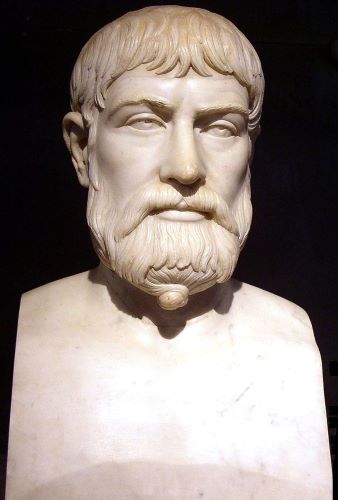
Considered to be ancient Greece’s greatest lyric poet, Pindar was born in Thebes in 522 B.C. He produced a considerable body of work most of which has not survived but which are known in part from quotations by other authors. His victory odes (epinikia) which were composed to celebrate triumphs in various athletic festivals, have survived. These 45 victory odes linked athletic achievement, aristocratic ancestry and a rich mythology of gods and heroes.
Words have a longer life than deeds.
Pindar
Pindar came from an aristocratic family and his writings were greatly influenced by his upper-class upbringing. Since most of the clients for which he wrote victory odes came from a similar background, his poetry associates athletic achievement with elite status. His writings also had strong religious overtones stressing the victor’s linkage not only with noble origins but also with immortal entities. He clearly believed that “power is born in the blood”, that the nobility enjoys some form of kinship with the gods and that long after the victors are dead “poems and legends (will) convey their noble deeds”. In reading Pindar, the first reaction is to think that this poet belongs to the Age of Aristocracy. Instead, he flourished during the era of Pericles when many Greeks were being swept up in the groundswell towards democracy.
Sweet is war, to those who know it not.
Pindar
Pindar spent most of his life in Thebes. When Alexander, the Great razed Thebes for defying him, he instructed his soldiers to spare the family home of the long dead poet. That was probably partially in recognition of poetry that Pindar had written praising Alexander I of Macedon but also in recognition of the high esteem in which Pindar was held by all Greeks.
Religion
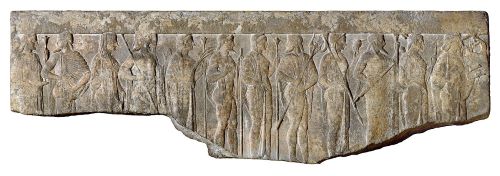
To the people of ancient Greece (as well as to earlier and neighboring civilizations) the universe they knew was filled with terrible forces not fully understood. Occasionally they saw dramatic demonstrations of power and might – violent thunderstorms, raging seas, gale force winds, eclipses, plagues, drought, earthquakes, volcanic eruptions, etc. It was not unreasonable to suspect that powerful and unpredictable entities were the cause of these events and that the originators might be appeased through prayer and sacrifice. In ancient times and in truly grave circumstances the ultimate gift of human sacrifice was made to placate those supernatural beings.
In time the number of these entities blossomed to represent or personify the virtues and vices of humankind, their wants, urges and fears. Eventually a complex realm was created, inhabited by greater and lesser gods and goddesses, heroes, titans, muses, graces, furies, fates, sirens and so on- each addition intended to account for another aspect of the human experience. Some of these deities and semi-deities were perceived as being benevolent; others were more likely to bring misery and distress. Petitions and sacrifices were made for two reasons: to make good things happen for the petitioner and to prevent bad things from coming to pass. The major deities lived on Mount Olympus and numbered twelve. Naturally, they were called “the Olympians”.
The king of the gods and father of many of them was Zeus. He was originally a weather god or sky-god controlling thunder, lightening and rain but as time went on he took on more responsibilities such as upholding justice and the law. Endowed with supreme strength and wisdom he was far more powerful than the other gods but, even so, he was subject to the limitations imposed by the three Fates, who controlled the destinies of humankind and, some said, of the gods themselves.
The god Poseidon, a brother of Zeus, not only looked after the seas; he was also in charge of earthquakes and horses. Quarrelsome, surly, petulant and greedy were some of the adjectives used to describe him and he was reputed to hold a grudge for a long time. His symbol was the trident or fish spear which could cause earthquakes or create springs when struck on the ground.
Hera was the sister and wife of Zeus, which automatically made her Queen of the gods. She was also considered to be the goddess of marriage, a particularly daunting task given the roving eye of the King of the gods- little wonder she was accused of being jealous.
Athena was the Greek goddess of wisdom and the daughter of Zeus and the goddess Metis, believed to be the wisest deity. Athena also looked after arts and crafts (technology) and was regarded as the guardian of the working woman.
Aphrodite was the goddess of love and concerned with beauty and procreation. She held a special place in the hearts of sailors.
Apollo was the god of music, of health, healing and human enlightenment. His twin sister Artemis was the goddess of hunting and, oddly enough, guardian of wildlife.
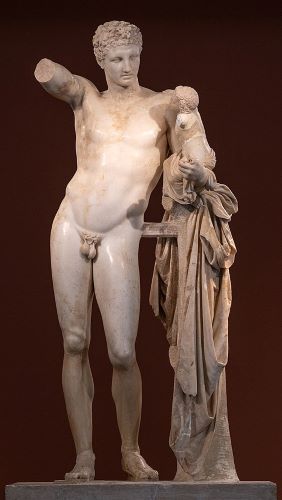
Ares was the god of war and essentially a troublemaker. Other major deities include Demeter, goddess of agriculture, Hermes, messenger of the gods as well as Dionysus and Hephaistos.
The ancient Greeks had no word for “religion” which they viewed as being part of everything they did. Nor did they believe in the separation of “church” and state. It was felt that the safety and security of the state was dependent on a good relationship with the gods. Anyone who offended the gods could be found guilty of impiety and sentenced to death, as happened to Socrates. No one undertook anything of an important nature- such as a voyage, a battle or a construction project without first seeking the blessings or support of a particular god. And when the task was successfully completed, thanks were given in the form of offerings or, perhaps, by the dedication of a plaque or monument. It was this practice that gave birth to most public buildings and monuments including the altar of Zeus at Pergamun and the renowned Parthenon.
The Greeks believed that the gods could see everything that humans did and could, if they choose, fulfill such needs as food, shelter and clothing as well as wants like love, wealth and victory. They sought the protection of the gods from their enemies, disease and the forces of nature. Ancient inscriptions and surviving writings show that the prayer usually sounded something like this…
Oh Great Poseidon, brother of Zeus, Lord and Ruler of the Seas, I call on you to help me once again. Last year I asked you to protect my ship and its crew during that violent storm. You made the waters tranquil almost immediately and I honored your name with offerings in your temple. This time, on the day of the month sacred to you, I am beginning a long voyage to a distant land and I seek your blessings for fair weather and calm seas. At dawn today I ask you to accept this offering.
Note that the prayer begins by identifying the god/goddess being petitioned, and the realm for which he or she was responsible. Former requests are mentioned, the results and the offerings made. Then the new request is presented for consideration.
According to an ancient Greek myth it was the titan Prometheus who was instrumental in determining the nature of the offerings to be made to the gods. He made up two bundles from the body of a sacrificed animal. In the smaller bundle he put all the choice cuts of meat. In the larger, he put the bones of the animal and covered it with fat. Zeus was asked to select the portion that should always be offered to the gods. Zeus quickly, and rashly, selected the larger bundle finding out later that he had passed up on the better portion.
If you find Greek religion and mythology to be a bit confusing and contradictory and feel that the behavior of some of the gods and goddesses was sometimes outrageous and improbable, then you are not alone. You are in the company of many Greeks who began some one hundred generations ago to question as to whether or not there might be better (although less interesting) explanations about the origins of the universe and themselves. They took their first steps into the discipline of philosophy.
Science and Philosophy
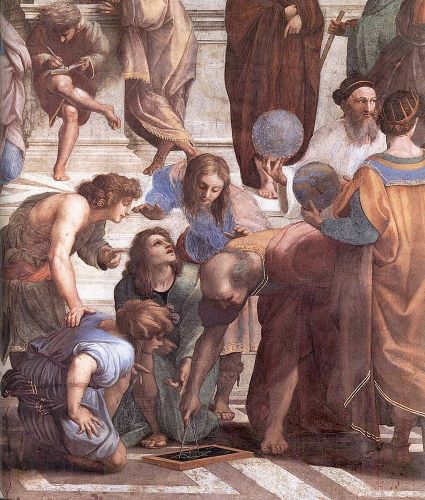
The safest general characterization of the whole Western philosophical tradition is that it consists of a series of footnotes to Plato.
Alfred North Whitehead
The ancient Greeks didn’t make a distinction between philosophy and science, nor did they recognize the range of disciplines such as physics, chemistry, mathematics, astronomy, etc. that we do today. There simply wasn’t the depth of knowledge and range of information that later made separate disciplines practical. In the Greek era, one individual could be an expert in several fields. Nowadays, with the tendency of specialists to know more and more about less and less (i.e. intensive knowledge about a rather limited field) the ability to keep abreast of detailed research in more than one area becomes almost impossible. But in the days of Thales, Pythagoras and Aristotle that was the norm. People expected an individual knowledgeable in one area to also be proficient in others. And many were.
We are what we repeatedly do.
Aristotle
The Greeks had great success in the areas of mathematics, particularly geometry, borrowing heavily from the Egyptians (who were concerned primarily with practical applications) while raising the theoretical and intellectual bar to new heights. Euclid’s classic book on the Elements of Geometry was the world’s main textbook for almost two millennia.
They also made their mark in astronomy. An understanding of astronomy was important in understanding and regulating the business of agriculture. It was also essential in developing an accurate calendar and critical for navigation. While the Egyptians and Babylonians had made great advances in astronomy, their work was based heavily on centuries of observation. It was the Greeks who introduced mathematics into astronomy greatly expanding the range of questions that could be asked and answered about the solar system. In the 3rd Century BC, the Greek astronomer Aristarchus advanced the theory that the sun, not the earth, was the center of the solar system. It took the world the better part of two millennia to come to the same conclusion. Eratosthenes, another Greek, accurately calculated the earth’s circumference and its diameter.
Physics, the study of the nature of things, began seriously in Greece in the 6th Century BC. With few exceptions (e.g. the work of Aristotle and Pythagoras) the study was an intellectual pursuit unaided by much in the way of controlled experimentation, which is standard practice today.
It was Aristotle, equally at ease as a philosopher and as a scientist, whose several treatises on animals laid the foundations of zoology. Aristotle also did important work on plants, although not nearly to the same extent as his thorough publications on animal life, but he did have a strong influence on other scholars, such as Theophrastus, who laid the groundwork for the science of botany.
One swallow does not make a summer.
Aristotle
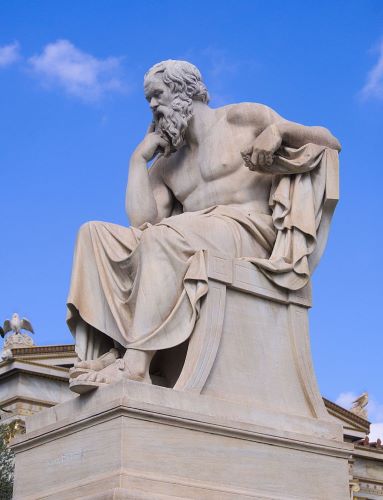
Socrates, although we have no evidence he ever wrote anything, was the first of the great thinkers of Athens. We can get some understanding of his ideas from the writings of Plato and Xenophon. Socrates challenged the morals and quest for power of his fellow citizens and paid the ultimate price of his life. He is remembered as the father of the study of ethics.
There were several factors that influenced the development of medicine in ancient Greece. First, there was the potent force of religion with its gods and goddesses who dealt with healing, death and pestilence. Then there was the influence of trading contacts such as Egypt (which had learned much from its mummification practices) and Mesopotamia (which had published comprehensive medical documents on clay tablets well before 1000 BC). From these and other Eastern areas, the Greeks also developed an encyclopedic range of herbal medicines.
To cap it off, there was the sad result of war – a variety of wounds and amputations caused by arrows, swords, spears and accidents- and described so vividly and accurately in Homer’s Iliad. Just dealing with these casualties provided lots of experience and practical information applicable elsewhere. Although Greek religion frowned on human dissection in the Archaic and Classical periods, after the founding of the Alexandrian School that changed. Physicians and researchers made advances in some areas that were not surpassed until the 18th Century.
The transition from believing that illnesses originated with the gods and the realm of evil spirits (a belief perhaps universally shared with all early civilizations) to the realization that there were natural causes involved did not happen easily or suddenly. For many generations two belief systems, one rooted in religion and one based on an emerging science, co-existed. Hippocrates, the Greek Father of Medicine, wrote “prayer indeed is good, but while calling on the gods a man should himself lend a hand.” To that end there were healing centers established where the faithful might pray while receiving the benefits of medical treatment. Hippocrates and his followers took a giant step forward in the science of medicine when they asked themselves the question “How did this illness come to be?” instead of “What god or force of evil caused this illness?”
Man is by nature a political animal.
Aristotle
Just as war drove significant improvements in medical practices so, too, did it have an impact on the field of engineering. Scholars such as Archimedes became military engineers, inventing and improving defensive and offensive weapons. There were, in addition, other innovations such as the gear, the screw, the steam engine, the screw press and so on but the prevailing Greek attitude towards manual labor and labor-saving devices did not greatly encourage nor reward innovation (except in the military sphere) so many inventions remained curiosities rather than instruments of change.
The Olympic Games
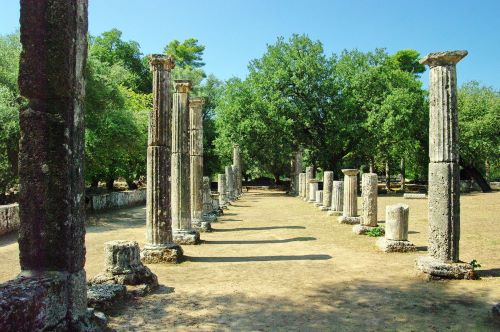
The ancient Olympics first took place in 776 BC at a place called Olympia, a sacred site dedicated to Zeus, king of the gods. (Located in the Alpheus river valley in southern Greece, Olympia should not be confused with Mount Olympus, located in northern Greece and legendary home of the major Greek gods.) Olympia was not only the original site of the Olympics; it was the permanent venue for 293 successive Olympics- one every four years for almost 1200 years. Among the ancient Greeks, a pilgrimage to Olympia to see the athletic events and to participate in the sacrifices to Zeus and other festivities was something of great importance and many people attended several times. Because it was a pagan festival it conflicted with the growth and spread of Christianity and Roman emperors, who were Christian, banned the Olympics around 400 AD.
For the first dozen or so Olympic games there was only one athletic event and that was the stadion or 200 meter (210 yard) race. The distance corresponded to the length of the stadium track. Later, other events were added. In the beginning the athletic contest lasted only one day but that was later increased with the addition of other competitions. The athletes, all male, competed naked. Since there were no stopwatches, there are no records of the winning times but the names of the winners and the various events they won over the years were carefully documented. Records show that in 724 BC a 400 meter (420 yd.) race was added and then, in succeeding years, other events (wrestling, boxing, chariot races, pentathlon, and longer distance races) were also included, increasing the success and popularity of the games.
Those headed off to the Olympics were making a religious pilgrimage and anyone who interfered with their passage was deemed to have committed a sacrilege against Zeus himself- something no Greek would do lightly. Wars were suspended, personal feuds were put on hold, and bandits and mercenaries took a holiday so that the travelers could make their way to and from the Olympic site without fear for their safety. Depending on the distance and the weather, it could be a daunting trip. Despite the difficulties a remarkable number of Greeks, including Socrates, made the trip and made it more than once.
Socrates offered the following advice to a timid prospective spectator:
What are you afraid of? Don’t you walk around all day in Athens? Don’t you walk home to have lunch? And again for dinner? And again to sleep? Don’t you see that if you string together all the walking that you do in five or six days anyway you can easily cover the distance from Athens to Olympia?
For the athletes it wasn’t just a matter of showing up on the day of the competition and performing. 30 days before the games began; athletes had to register in person before the ten Olympic judges. Many would be accompanied by their personal trainers and coaches. The first thing that the judges did was to ensure that the athlete presenting himself was truly Greek and eligible to compete. The second thing was to make certain that those who wanted to compete were capable of doing so at the highest level. To that end, the judges conducted trials and workouts calculated to weed out those at the weaker end of the spectrum. The competitors ate together at a common mess to ensure that no one gained an advantage with secret recipes and magic potions. It is interesting to note that there were no team sports at those Olympics.
Women in Ancient Greece
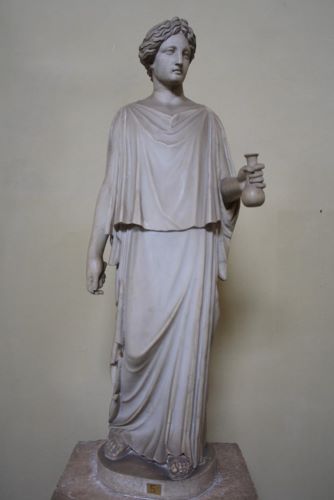
The male is by nature superior and the female inferior…the one rules and the other is ruled.
Aristotle
In comparison with other civilizations in the ancient world, Greek women in general did not enjoy high status, rank and privilege. Even so enlightened a man as Pericles suggested in a major public speech that the more inconspicuous women were, the better it was for everyone. Sparta, which history clearly ranks as the cultural inferior of Athens on almost every scale, seems to have had a superior record in its treatment of women. And it wasn’t outstanding.
At social gatherings, intellectuals argued that perhaps men and women were two separate species. Men had more in common with the gods, while women had far more in common with the animal kingdom. (Perhaps this was an earlier, and fundamentally flawed, version of Men are from Mars: Women are from Venus). In any event, despite the efforts of many to ensure that women stayed in their proper place in the home and out of sight, a few did succeed in escaping that orbit. None flew as high as women in Egyptian society where several attained the highest office in the land- that of Pharaoh- but some Greek women managed to leave a public legacy. Following are three of them.
Penelope, wife of Odysseus, may not have existed at all but she still succeeded in leaving a legacy taught to new generations of Greeks for centuries by itinerant poet-storytellers. The virtues, values and roles ascribed to Penelope became, in effect, the standard to which women in that situation were expected to aspire. The story is well known.
Odysseus, King of Ithaca and the man responsible for the idea of the Trojan horse tried to return home after the long war with Troy. But he had offended Poseidon and the ruler of the seas threw many obstacles in his path. Odysseus, a reluctant warrior, had left his household in charge of his wife. Now she was being besieged by suitors who thought her husband was dead and wanted his wife and valuable property. Penelope outsmarted them. The woman that Homer portrays is one who can stand on her own two feet, is a partner with her husband in the life of the family and a real role model.
Aspasia, daughter of Axiochus, was born in the city of Miletus in Asia Minor (present day Turkey) around 470 BC. She was highly educated and attractive. Athens, at that time, was in its golden age and as a city must have had the kind of appeal that New York, London and Paris have today. Aspasia moved there around 445 BC and was soon part of the local social circuit. Some of the most influential minds of the era spoke highly of her intelligence and debating skills. Socrates credited her with making Pericles a great orator and with improving the philosopher’s own skills in rhetoric. She contributed to the public life of Athens and to the enlightened attitude of its most influential citizens.
Hypatia, daughter of Theon of Alexandria, was born in that city around 350 AD. She studied and later taught at the great school in Alexandria. Some modern mathematicians acclaim her as having been “the world’s greatest mathematician and the world’s leading astronomer”, a viewpoint shared by ancient scholars and writers. She became head of the Platonist school at Alexandria lecturing on mathematics, astronomy and philosophy attracting students from all over the ancient world. Political and religious leaders in Alexandria sought her advice.
Democracy
Ancient Greece, in particular Athens, is rightfully credited as the birthplace of democracy. Democracy is “rule by the people” and rule by the majority is implied. Up to this time, in most societies, rule was by kings, pharaohs, emperors, chiefs, warlords- powerful men (usually) who had become accepted as leaders because of their superior skills or force of personality.
Usually, their position then became a hereditary one, passed down to the eldest (or strongest) son. Kinship played an important role with powerful families and clans supporting the right of the king to rule. In some societies, the king was also the High Priest and had the additional power of religion to back his claim. The idea that common people had the ability to govern was a new and radical one.
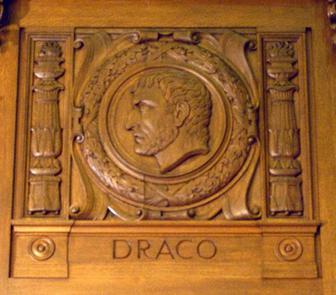
The road began with Draco. In the early 7th century BC Athens, and the surrounding area of Attica, was a community governed not by laws but by tradition. If a family member was killed (deliberately or accidentally) it was up to the family to seek retribution. That could take the form of killing a member of the offending family or obtaining a suitable financial penalty from them. (In fact there were established sanctuaries in which families in danger could take refuge while the financial details of a settlement were being negotiated.)
The poor and the weak were at a disadvantage in this system against powerful households. Eventually this caused considerable unrest. So, by some unknown process, an individual named Draco was chosen as a lawgiver, to put crimes and punishment into a body of laws that everyone had to obey. This he did during the 39th Olympiad (between 624-621 BC). For the first time the Greeks had the rule of law to guide them rather than individual discretion or preference. This had the effect of making the state and not the family responsible for enforcing the law and the intention was that the law would apply equally to all men, rich or poor.
For the first time a distinction was made between someone killed deliberately and someone killed accidentally. Previously there had been no distinction made and the penalty was the same. (Even things could be punished. There is a story told about a statue falling on top of someone and killing him. The statue was flogged and cast into the sea as punishment.)
Draco’s laws may have been fair but they were severe. Death was the punishment for offences that we might consider minor. Generations later a Greek orator lamented that Draco’s laws were written not in ink but in blood. The laws also did not address a major problem at the time- people were being put into prison or forced into slavery because of debt. Soon it became evident that the laws needed to be reviewed and revised.
The man chosen by the people for this task had a reputation for wisdom. Solon was both a politician and poet. Since most of his writing has survived it is possible to get an insight into his philosophy and thinking. His task was challenging- to address social inequities that by this time had Athens hovering on the brink of civil war – and to do so without alienating either the rich or those crushed by debt.
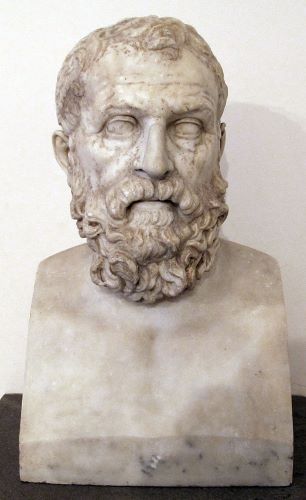
What was urgently needed and what Solon provided was economic reform. He forgave debts secured by either land or personal liberty and he forbade entering into such contracts in the future. He sidestepped the issue of land re-distribution while offering poor farmers the prospect of a brighter future. The laws of Draco were repealed and replaced with a more humane code of conduct that covered civil, criminal and religious matters. This became the foundation of the Athenian legal system for at least the next three centuries. New standards were set in place for weights and measures, coinage and other economic instruments. Wealth, not birth, determined eligibility for political office with those contributing most to the economy having a greater voice in managing it. Then, after securing a promise from the citizens not to tinker with the new system for a decade, Solon left Greece to travel abroad.
Although Solon’s legal legacy remained in use for some fifteen generations his political system did not last beyond his lifetime. An economic tug of war broke out among the various factions over the issue he did not address- the redistribution of land. Finally, a wily nobleman named Peisistratus seized power and formed a dictatorship to rule over Athens. In addition to land reform, he also made other economic improvements, carried out an extensive public works building program and was a strong supporter of the arts. Although called a “tyrant”, a better description would be a benevolent dictator, who earned a reputation during his reign as a principled, fair and humane ruler.
His son Hippias did not do as good a job and was forced from office. A Greek aristocrat named Cleisthenes, who deserves recognition as the father of Athenian democracy, fought for the concept of greater citizen involvement in the political life of Athens. He recognized that the traditional tribal organization of the city had become a divisive rather than a unifying force. A new re-organization split up the tribes and balanced representation. From then on, individuals were not only encouraged to participate in what became known as Athenian democracy; they were required to participate.
The next great leader of Athens was Pericles who believed strongly that society functions best when all citizens are free and share in the running of the state. So, in the space of 150 years the center of power had moved from those of aristocratic birth, to those with wealth, to the common people. Although the style of government under Pericles was called a democracy the great Greek historian Thucydides said, “It was in theory, a democracy, but in fact it became the rule of the first Athenian.” (Pericles) The viewpoint of Pericles was expressed best in a funeral oration he gave in 430 BC, of which an excerpt follows:
Our system of government does not copy the systems of our neighbors: we are a model to them, not them to us. Our constitution is called a democracy, because power rests not in the hands of the few but of the many. Our laws guarantee equal justice for all…as for the election of public officials, we welcome talent to every arena of achievement nor do we make our choices on the grounds of class but on the grounds of excellence alone…we differ from other states in regarding the man who keeps aloof from public life not as “private” but as useless…great indeed are the signs and symbols of our powers…men of the future will wonder at us, as all men do today…
Athenian democracy was quite different from what we would consider to be democratic today. At that time, not everyone was considered a citizen and eligible to vote. Women were not citizens and so could not participate in any fashion. Neither could Greeks from other city-states living in Athens, nor foreigners, nor the large slave population. In a city of perhaps 300,000 less than 40,000 males were citizens and participants in the new democracy. But it was a giant step forward as far as government of, by and for the people was concerned.
One might ask, “Why did democracy develop first in Athens?” Answers vary. Some have suggested that the inhospitable soil (which Plato compared to a bony skeleton) played a part. A Greek myth speaks of Zeus apportioning the land of the World. First he ran all the soil through a sieve and distributed it to the various nations. Left in the sieve were rocks, pebbles and parched earth. This he tossed over his shoulder saying “That’s for Greece”. In those conditions people had to fight the soil and it toughened their spirit.
Others credit the sea as the source of independence, still others the isolation of communities and the need to make one’s voice heard whatever the eventual outcome. As Pericles noted “Instead of looking on discussion as a stumbling block in the way of action, we think it an essential preliminary to any wise action at all. “
It was likely a unique combination of circumstances and individuals that converged to create a system of government built around the contributions of the common man.
Science of Archaeology
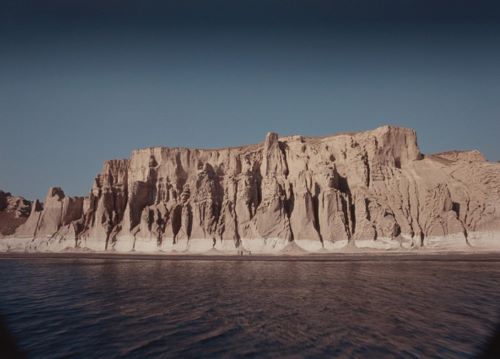
The Dictionary definition of “archaeology” reads like this- The scientific study of material remains (as fossil relics, artifacts and monuments) of past human life and activities.” (Webster’s) Paul Bahn has a more memorable one…
Archaeology is rather like a vast, fiendish Jigsaw puzzle invented by the devil as an instrument of tantalizing torment, as Paul Bahn writes:
- It will never be finished
- You don’t know how many pieces are missing
- Most of them are lost forever,
- You can’t cheat by looking at the picture.
One image we may have of archaeologists comes out of Hollywood- the “Indiana Jones” model- a tall, lean man wearing a battered leather hat, revolver mounted on his hip, a half-smile on his tanned face as he contemplates a dangerous quest to a foreign land in search of some kind of treasure, pursued by bad guys, adventure lurking around the next exotic corner. That picture was not entirely fabricated. It was based on the exploits of early explorers- people such as the American dinosaur hunter Roy Chapman Andrews and Britain’s Sir Austen Henry Layard, both of whom made astonishing discoveries amidst the dangers and challenges of disease, poisonous snakes, natural disasters, ruthless bandits, civil war and corrupt bureaucracies. Both have been suggested as the inspiration for the Indiana Jones character.
One should not conclude that archaeology is something that began in the past 2-3 centuries. More than two millennia ago the king of Babylonia ordered the careful excavation of a temple in the city of Sippar (located southwest of today’s Baghdad) to see if he could determine who had built the temple. Ancient Greeks of the same era did some archaeological excavations in Delos, trying to make sense of the grave goods they found buried with the inhabitants. However it is in the last 2-3 centuries that archaeology has evolved into a science, one whose goal of treasure hunting has been replaced with the goal of uncovering the secrets of the past. That sentiment is best expressed in the observation of General Augustus Pitt-Rivers that, in general, everyday objects are more useful in interpreting the past than unique ones are.
Along the way though, archaeology has had its colorful characters, some of whom were extremely gifted individuals blessed with imagination and curiosity (and, sometimes with money), some had well-developed linguistic talents, others had organizational and leadership skills coupled with a lot of self-confidence. Most had a passionate desire to solve puzzles that had stumped their predecessors- lost cities, forgotten languages, buried temples, things remembered only in myths and legends. These were the kind of challenges that drove people such as: Jean-Francois Champollion, Heinrich Schliemann, Michael Ventris, Yuri Knosorov, John Lloyd Stephens, Sir Arthur Evans, General Augustus Pitt-Rivers, Sir Mortimer Wheeler, Howard Carter, Sir William F. Petrie and a host of others.
Often it was well-diggers, farmers, construction workers, hikers, cavers or children playing who stumbled upon something that later proved to be an important piece of local heritage. In such a manner were the tomb of the First Emperor of China, the Lascaux Caves, the buried Bronze Age city of Akrotiri and many other archaeological sites brought again to the attention of the public. Natural processes such as erosion, flood and earthquakes exposed other long-hidden secrets to the light of day. Once discovered, quick action was required in order to prevent destruction of the site by modern day tomb robbers, tourists and souvenir hunters. There have been many instances where the authorities didn’t act quickly enough.
In the early days, excavation and archaeology were considered to be almost synonymous terms. Excavation is still the main method of investigating most sites. Excavation tools range all the way from bulldozers down to shovels, picks, dental tools and paint brushes. The most important tool, generally, and the one that is practically a symbol of the archaeology profession is the mason’s trowel- a sharp-pointed, wedge-shaped implement that looks somewhat like a pie lifter with a wooden handle. In the hands of an experienced archaeologist the trowel can remove a lot of earth, delicately, in a short period of time without damaging the artifacts.
Today a wide range of tools, virtually all developed for other applications, can be used in an archaeological examination. Some are more suitable than others, depending on the characteristics of the site and the preferences of the archaeologist. As in any profession, some practitioners are more comfortable and proficient with certain tools than others. Some have taught themselves to handle a bulldozer as delicately as a surgeon’s scalpel. Some place their reliance on tools and techniques that others use sparingly or not at all. It could be said that there is a lot of art as well as science in the realm of archaeology.
The term “stratigraphy” in archaeology refers to occupation layers. Digging down through each layer or stratum the experienced eye will notice differences in the colour of the soil, differences in the type of soil and differences in the materials that are found in the soil. It is like cutting through a layer cake with the layers on top, of course, being newer or more recently laid down than the layers on the bottom. (You do have to be careful that the layers weren’t disturbed, turned over by a shovel, plow or animal or pulled out of position by a well or pit, so that the layers are reversed or mixed up.) Stratigraphic analysis is a very important tool in archaeology, as it is in geology. In the film one can clearly see the different strata or layers laid down by the erupting volcano.
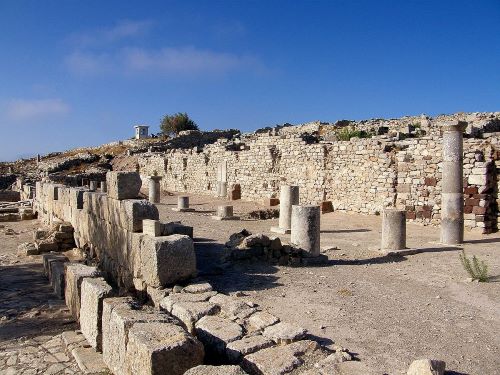
Ice core dating is very similar to dendrochronology or tree ring dating. Seasonal variation in both the ice cores and tree rings allow one to count the number of years shown in an ice core or wood sample. One of the inclusions regularly found in ice core samples is volcanic ash. In the film the presence of such ash was used to establish a precise date for the volcanic eruption that destroyed Thera.
In the film Ground Penetrating Radar (GPR) is shown in action. The equipment can also be put on a small cart or wagon and pushed or pulled around the site. GPR works by sending ultra high radio frequency waves down into the ground. These reflect off buried walls, pipes, etc. and provide an electronic profile of what may lie beneath.
Different trees and plants produce different amounts and types of pollen (microspores involved in plant reproduction). These vary throughout time and place. By collecting and analyzing the spores it is possible not only to build up a picture of a particular environment; that environment can also be dated. Pollen analysis is an important tool in understanding the environmental challenges faced by prehistoric peoples.
Computer technology has revolutionized the practice of archaeology just as it has had an enormous impact on most other professions. A generation ago it could take years to collect, sort, analyze and publish the data from an archaeological excavation- particularly if the site was at all complex. Now laptops right on the site can collect the information and there are software programs that can shorten the sorting and analytical timeframe considerably. Instead of moving heavy columns, “what if” programs can be used to try out different configurations and models on the computer. In the film, Professor Doumas confirms that the computer has become an indispensable archaeological tool.
In recent years some archaeologists have become interested in what is called experimental reconstruction. Using stone tools produced by the same techniques used by prehistoric hunters the archaeologists have butchered both elephants and bison to find out how the process was done, how long it would have taken and how tools marks found on ancient mammoths compare. The voyage of the Kon-tiki by Thor Heyerdahl, the raising of an Egyptian obelisk and the transporting of massive building stones in Greece and Egypt were all successful experiments to demonstrate the feasibility of something. Nowadays we can go one step further and do some of the experimentation in the computer. In the film there is a striking computer reconstruction of the Parthenon showing the temple as it most probably looked shortly after it was completed. If further research indicated the addition, removal or alteration of a particular feature, the computer model could be easily updated.
The Parthenon
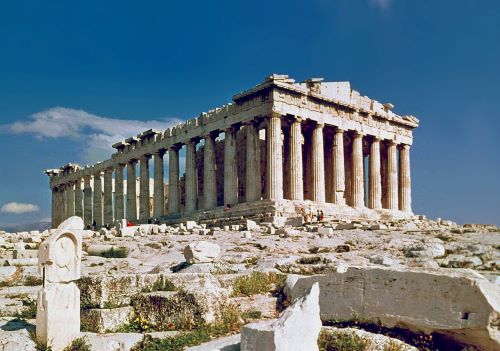
The Parthenon is one of the best-known architectural symbols of any civilization. Built in the 15-year period between 447-432 BCE this ancient Greek temple was designed as a replacement for a temple destroyed by the Persians in 480 BC. To build a temple of this size (101 x 228 ft.; 30.9m x 69.5m) in that short a timeframe was considered amazing but what was even more amazing was the quality of construction and finishing, which was superb. The leading politician of the day and the man behind the construction project was Pericles. According to Plutarch, the great Greek biographer writing centuries after the building was completed; one of the main reasons for the construction of the Parthenon and the other temples which surrounded it was the need to deal with growing unemployment. By embarking on a major public works program for the acropolis (the towering hill in Athens where the Parthenon and other temples dedicated to the gods were located) Pericles hoped to provide jobs for ordinary Athenians- carpenters, stonemasons, ivory-workers, painters, enamellers, pattern-makers, blacksmiths, rope-makers, weavers, engravers, merchants, coppersmiths, potters, shoemakers, tanners, laborers, etc.
At the same time and more importantly, he envisioned the Parthenon as an architectural masterpiece that would make a statement to the world about the superiority of Athenian values, their system of governance and their way of life. Because of this, only the best building materials were good enough- the finest stone, bronze, gold, ivory, ebony, cypress-wood- and the best artists and craftsmen. It was to be a building for the ages. In a funeral oration delivered in 430 BC Pericles expressed his pride in the city of Athens and there seems no doubt he was thinking of the Parthenon when he noted that “Mighty indeed are the marks and monuments we have left. Men of the future will wonder at us, as all men do today.”
The new construction project was not welcomed by everyone. There were some who were outraged that so much money was being spent on the construction “gilding and beautifying our city as if it were some vain woman decking herself out with costly stones and thousand talent temples”. Many were also upset that the monies to build the Parthenon were being supplied, reluctantly, by Athenian allies who had originally handed over this money for use in any future conflict against the Persians. Pericles argued that as long as the Athenians honored their commitment to defend these allies against Persian aggression, then the allies had nothing to complain about. And the majority of people supported Pericles. In fact his most vocal opponent was ostracized (banished for ten years) by a popular vote leaving the way clear to proceed with construction.
The Parthenon building program was carried out under the general direction of Pericles himself. He chose three men at the top of their professions to collaborate on the design and execution of the project. Although we don’t know everything that each did, it seems that Ictinuswas the chief architect, Callicratus acted as the project contractor and technical coordinator while Phideas was responsible for overseeing and integrating all artistic elements. He also personally created the enormous gold and ivory sculpture of the city goddess and produced some of the various sculptural groupings while supervising the production efforts of a small army of artists and craftsmen. Phideas was recognized at the time as being the greatest sculptor of his era but is acknowledged now as the greatest Greek sculptor of all time. The collaboration of the threesome was an enduring success.
There is no denying that the Parthenon construction project was expensive. (The cost, according to public accounts engraved in stone, was 469 silver talents. Attempts to translate that into a modern equivalent aren’t entirely satisfactory.) The main building material was Pentelic marble quarried from the flanks of Mt. Pentelikon, located about 10 mi/ 16 km from Athens. (The old Parthenon, the one destroyed by the Persians while it was partway through construction was the first temple to use this kind of marble.) The huge pieces of stone had to be hauled to the building site by oxcart. This structure was, by no means, the largest but what distinguishes the Parthenon from most other temples is the quality and extent of the sculptures. Many of the sculptures were made of the more expensive Parian marble, from the island of Paros, which most sculptors proclaimed the best kind of marble for their work. As a collection that shows Greek art at its zenith the Parthenon marbles (sculptures) are simply without peer.
The building itself is a work of art incorporating a number of aesthetic refinements calculated to make it appear as visually perfect as possible. Knowing that long horizontal lines appear to sag, even though they are absolutely straight, horizontal elements were deliberately curved and the vertical columns “fattened” in the middle to compensate for the vagaries of the human eye. This thickening in the middle made it look as though the columns were straining a bit under the weight of the roof, thus making the temple less static, more dynamic. Although the lines and distances in the Parthenon appear to be straight and equal, the geometry has been altered to achieve that illusion. It has been said about this building that “nothing is as it appears”.
The Parthenon is a Doric temple, which artfully incorporated selected Ionic features to produce a building that many, including some of the world’s top architects, have called perfect. The Doric style uses thicker columns and has a more massive appearance (sometimes called masculine) than the Ionic (feminine) style. This may have been a politically inspired choice by Pericles, symbolically uniting Greeks of Dorian and Ionian backgrounds in one transcendent building.
The Parthenon is classified as a peripteral temple, that is, the perimeter of the structure is defined by columns, in this case by eight on the narrow ends and seventeen on the long sides, for a total of 46 columns. Sitting inside the exterior columns is a raised stone platform. This supports the floor-to-ceiling walls of a shoebox-like room called the Cella or Naos. In traditional temples this is a single room but in the case of the Parthenon, the Cella has been divided into two rooms. In the larger one, a huge standing statue of Athena was located, resting on a support slab. In front of the statute…a reflecting pool. In the smaller room, with the four interior columns, was kept the state treasury, including cash gifts to the deity. The collection of interior columns was necessary to support the roof that, like the rest of the building, was made of marble.
The portion of the Cella where the magnificent statue of Athena was kept was called the Hekatompedon (heka = 100) which was a hundred Athenian (Attic) feet in length, as the Greek room name indicates. The reflecting pool was filled with water to add humidity to the air and prevent splitting of the ivory elements of the huge chryselephantine (composite gold and ivory) statue. It is worth noting that the statue cost more than the building built to house it and the sculptor Phideas made it so that it’s gold panels could be removed, weighed and sold should the need arise. (That proved to be a wise decision because when he was later accused of pilfering some of the gold, he was able to quickly establish his innocence.)
None deny that the Parthenon building is a work of art in its own right but it was also embellished with a dazzling array of quality sculptures.
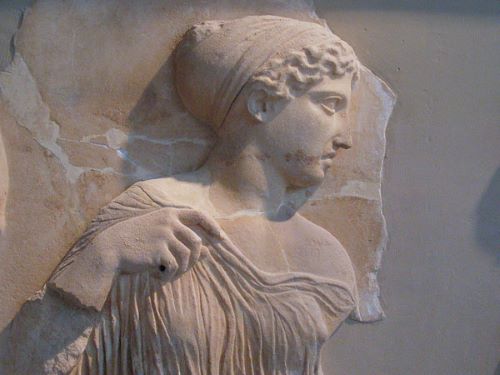
The Parthenon is one of the best known architectural symbols of any civilization. Built in the 15 year period between 447-432 BC this ancient Greek temple was designed as a replacement for a temple destroyed by the Persians in 480 BC. To build a temple of this size (101 x 228 ft.; 30.9m x 69.5m) in that short a timeframe was considered amazing but what was even more amazing was the quality of construction and finishing, which was superb. The leading politician of the day and the man behind the construction project was Pericles. According to Plutarch, the great Greek biographer writing centuries after the building was completed; one of the main reasons for the construction of the Parthenon and the other temples which surrounded it was the need to deal with growing unemployment. By embarking on a major public works program for the acropolis (the towering hill in Athens where the Parthenon and other temples dedicated to the gods were located) Pericles hoped to provide jobs for ordinary Athenians- carpenters, stonemasons, ivory-workers, painters, enamellers, pattern-makers, blacksmiths, rope-makers, weavers, engravers, merchants, coppersmiths, potters, shoemakers, tanners, laborers, etc.
At the same time and more importantly, he envisioned the Parthenon as an architectural masterpiece that would make a statement to the world about the superiority of Athenian values, their system of governance and their way of life. Because of this, only the best building materials were good enough- the finest stone, bronze, gold, ivory, ebony, cypress-wood- and the best artists and craftsmen. It was to be a building for the ages. In a funeral oration delivered in 430 BC Pericles expressed his pride in the city of Athens and there seems no doubt he was thinking of the Parthenon when he noted that “Mighty indeed are the marks and monuments we have left. Men of the future will wonder at us, as all men do today.”
The new construction project was not welcomed by everyone. There were some who were outraged that so much money was being spent on the construction “gilding and beautifying our city as if it were some vain woman decking herself out with costly stones and thousand talent temples”. Many were also upset that the monies to build the Parthenon were being supplied, reluctantly, by Athenian allies who had originally handed over this money for use in any future conflict against the Persians. Pericles argued that as long as the Athenians honored their commitment to defend these allies against Persian aggression, then the allies had nothing to complain about. And the majority of people supported Pericles. In fact his most vocal opponent was ostracized (banished for ten years) by a popular vote leaving the way clear to proceed with construction.
The Parthenon building program was carried out under the general direction of Pericles himself. He chose three men at the top of their professions to collaborate on the design and execution of the project. Although we don’t know everything that each did, it seems that Ictinuswas the chief architect, Callicratus acted as the project contractor and technical coordinator while Phideas was responsible for overseeing and integrating all artistic elements. He also personally created the enormous gold and ivory sculpture of the city goddess and produced some of the various sculptural groupings while supervising the production efforts of a small army of artists and craftsmen. Phideas was recognized at the time as being the greatest sculptor of his era but is acknowledged now as the greatest Greek sculptor of all time. The collaboration of the threesome was an enduring success.
There is no denying that the Parthenon construction project was expensive. (The cost, according to public accounts engraved in stone, was 469 silver talents. Attempts to translate that into a modern equivalent aren’t entirely satisfactory.) The main building material was Pentelic marble quarried from the flanks of Mt. Pentelikon, located about 10 mi/ 16 km from Athens. (The old Parthenon, the one destroyed by the Persians while it was partway through construction was the first temple to use this kind of marble.) The huge pieces of stone had to be hauled to the building site by oxcart. This structure was, by no means, the largest but what distinguishes the Parthenon from most other temples is the quality and extent of the sculptures. Many of the sculptures were made of the more expensive Parian marble, from the island of Paros, which most sculptors proclaimed the best kind of marble for their work. As a collection that shows Greek art at its zenith the Parthenon marbles (sculptures) are simply without peer.
The building itself is a work of art incorporating a number of aesthetic refinements calculated to make it appear as visually perfect as possible. Knowing that long horizontal lines appear to sag, even though they are absolutely straight, horizontal elements were deliberately curved and the vertical columns “fattened” in the middle to compensate for the vagaries of the human eye. This thickening in the middle made it look as though the columns were straining a bit under the weight of the roof, thus making the temple less static, more dynamic. Although the lines and distances in the Parthenon appear to be straight and equal, the geometry has been altered to achieve that illusion. It has been said about this building that “nothing is as it appears”.
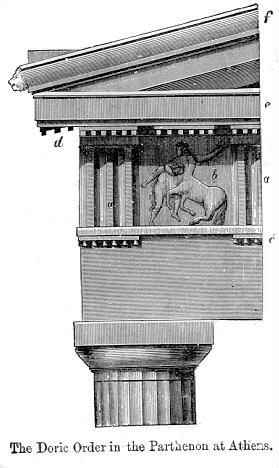
The Parthenon is a Doric temple, which artfully incorporated selected Ionic features to produce a building that many, including some of the world’s top architects, have called perfect. The Doric style uses thicker columns and has a more massive appearance (sometimes called masculine) than the Ionic (feminine) style. This may have been a politically inspired choice by Pericles, symbolically uniting Greeks of Dorian and Ionian backgrounds in one transcendent building.
The Parthenon is classified as a peripteral temple, that is, the perimeter of the structure is defined by columns, in this case by eight on the narrow ends and seventeen on the long sides, for a total of 46 columns. Sitting inside the exterior columns is a raised stone platform. This supports the floor-to-ceiling walls of a shoebox-like room called the Cella or Naos. In traditional temples this is a single room but in the case of the Parthenon, the Cella has been divided into two rooms. In the larger one, a huge standing statue of Athena was located, resting on a support slab. In front of the statute…a reflecting pool. In the smaller room, with the four interior columns, was kept the state treasury, including cash gifts to the deity. The collection of interior columns was necessary to support the roof that, like the rest of the building, was made of marble.
The portion of the Cella where the magnificent statue of Athena was kept was called the Hekatompedon (heka = 100) which was a hundred Athenian (Attic) feet in length, as the Greek room name indicates. The reflecting pool was filled with water to add humidity to the air and prevent splitting of the ivory elements of the huge chryselephantine (composite gold and ivory) statue. It is worth noting that the statue cost more than the building built to house it and the sculptor Phideas made it so that it’s gold panels could be removed, weighed and sold should the need arise. (That proved to be a wise decision because when he was later accused of pilfering some of the gold, he was able to quickly establish his innocence.)
None deny that the Parthenon building is a work of art in its own right but it was also embellished with a dazzling array of quality sculptures.
The famous Parthenon frieze was a 160 meter (524 ft.) long mural, carved in high relief, a continuous band of sculpture. It encircled the Cella at the ceiling. It would have been very difficult to see and appreciate from the temple floor, the usual place from where it could be seen. The height of the frieze was just in excess of one meter (about 41” tall) and the depth of the relief was about the width of a dollar bill. (Phideas had the top portion of the frieze cut to that depth and the bottom portion incised somewhat less so as to make the scenes more apparent from the distant floor.) Despite the fact that it would have been difficult to discern details of the artwork from that viewpoint, especially given the dim, shadowy light of the temple, no less care was lavished on these images than on the other groupings. If only the gods could see and appreciate them, then that was sufficient.
The frieze tells the story of the Great Panatheniac procession- a major parade, festival and games that took place in Athens every four years. (Each year a smaller event called the Lesser Panathenaea also celebrated the birthday of the goddess.) On each occasion, a new peplos (robe), woven by selected maidens would be presented to the goddess, who was also the patroness of weaving. The frieze tells the story of the marshalling of the parade, depicted on the western end, the parade participants (musicians, horsemen, priests, maidens with offerings, sacrificial animals, etc.) winding around both sides of the building, heading east. On the eastern side, seated gods and goddesses and standing civic and religious leaders gather to receive the new garment and, naturally, to make speeches.
On the West Pediment, there are two triangular pediments, one on each narrow end of the structure, and these were commonly used on temples as a place within which to display sculptures appropriate to the nature of the building. The theme of the west pediment is the mythological competition between Athena and Poseidon to determine who should be patron of the city. Each offered a gift, a saltwater spring from Poseidon symbolizing sea power, and an olive tree from Athena. The people deemed the latter to be more practical. (Olives were a favorite food item and the oil was used in lamps, for cooking and in cosmetics as well as being a prime trading staple.) In this sculptural grouping, the key figures are Athena and her uncle, Poseidon. They occupy the central, high point of the triangle and various other participants are assembled on each side- Cecrops, half-man, half-serpent founder and first king of Athens, Erechtheus, the second king, various water divinities, Hermes, Iris, etc.
The East Pediment grouping of sculptures was in the most advantageous location to be seen and appreciated by anyone approaching the temple via the usual route. Appropriately, the theme dealt with the birth of Athena, which took place in the presence of the other gods and goddesses. The story is well-known. Zeus had developed a splitting headache and great pressure in his head, for which he could find no relief. He ordered his son, Hephaistos, to strike him across the head with his axe, to relieve his symptoms. From that opening sprang a fully-grown Athena, dressed in complete battle regalia. Instead of the wail of a new-born baby observers heard the sound of a battle cry. The sculptural setting commemorates the event in stone. A seated Zeus fittingly occupies center stage with central players Athena and Hephaistos, while other deities take in the miraculous occasion.
The Parthenon actually had two friezes. One, already described, ran around the exterior of the Cella. The second, which encircled the exterior of the building, just underneath the roof overhang, is a typical Doric frieze with alternating triglyphs and metopes. (The triglyph is a projecting block featuring two vertical, parallel glyphs or grooves. It is about 2/3rds the width of a metope and it alternates with the metopes for the length of the frieze. On the Parthenon there are 92 metopes (32 on each side and 14 on each end), each roughly 1.20 meters (48” square).
The metopes on the Parthenon substantially exceed the usual temple standard for such embellishment. Each metope on the Parthenon is decorated, carved in high relief to the point that in some examples it is akin to sculpture in the round. Each side of the building had its own story to tell.
On the West is the Amazonomachy. This end depicts a battle between the Greeks and the Amazons. According to Greek mythology, the Amazons were a bellicose tribe of women descended from Ares, the god of war. Heracles came into conflict with the tribe in the course of doing his twelve labours. Symbolically this battle, and the others shown, symbolized the defeat of the barbarians (the Persians) by civilization (the Greeks).
On the East is the Gigantomachy. This end portrays the mythical battle between the Giants and the gods for the control of Mount Olympus.
On the North is the Trojan War. The subject on this side is the Trojan War, a favorite topic for illustrations for temples as well as vase paintings.
On the South is the Centauromachy. Unlike the sculptural groupings on the other three sides that were all badly defaced and disfigured by early Christians, for some unknown reason, the South escaped that fate. Depicted is the mythical battle between the Lapiths and the Centaurs where the drunken Centaurs, who had been invited to the Lapith wedding party, tried to make off with the Lapith women.
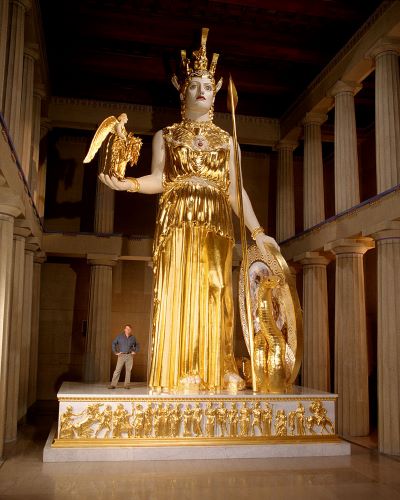
The chryselephantine statue of Athena. This was a huge work of art by any standard, at least 40 feet (12 meters) in height, a formidable figure in gold and ivory with gems for eyes and outfitted with her full panoply of weapons and symbols. (Chryselephantine comes from the word chryso (gold) and elephantine (ivory). It was a standard technique of the Greek Classical period whereby beaten gold for clothing and ivory for flesh was attached to a wooden armature or core. It is estimated that the gold on the statue alone was worth many millions of dollars. According to early Greek writers, the tyrant Lachares later stripped the goddess of her gold and used it to pay his army. It was said that the statue was later supplied with a coat of gilt by way of replacement.
The figure of Winged Victory- “Nike”- held in the right hand of Athena was six feet tall. In her left hand she supports both a spear and her shield. Entwined inside the shield is a serpent representing Erechtheus, an early king of Athens, son of the earth goddess Gaia but who was raised by Athena.
After the Parthenon project was completed Phideas went on to build an even larger and more renowned sculpture, that of the god Zeus, at Olympia. That became one of the seven wonders of the ancient world, and the model for the Lincoln Memorial in Washington. What happened to the Athena sculpture? It was taken to Constantinople by the Byzantines by the fifth Century AD. Then, no one is sure when, it disappeared.
The dream of Pericles, that the Parthenon would be an imperishable symbol of the greatness of Athens and of the inevitable triumph of civilization over the forces of barbarism, was short-lived. The last of the sculptural ornaments was completed in 432 BC but only three years later Pericles and many of his fellow citizens succumbed to a horrific plague that devastated Athens.
The Parthenon served as a temple to Athena for almost a millennium. Then, in the 6thh Century AD, Christian monks from the Greek Orthodox Church took over the building which became known as the Church of Holy Wisdom (Hagia Sophia). The zealous Christians smashed or defaced a number of the sculptures that they felt were pagan or secular and they made minor alterations to the architecture. 700 years passed.
In 1204 the French (Franks) invaded Athens and took over control of the Parthenon, renaming it Notre Dame d’Athenes (Our Lady of Athens). It was now a Catholic church. By 1458 Athens was overrun by the Turks who promptly converted the ancient Greek temple into an Islamic mosque, complete with minaret. The Turkish governor took over the adjacent Erechtheum (the temple which features caryatids, draped female figures, in lieu of columns), in which to accommodate his harem. In 1687 the Venetians, who were warring against the Turks, bombarded the Parthenon with mortar and cannon fire. The Turks had felt so confident that the Venetians would not attack this venerable religious building that their women and children were sheltered inside- along with their stores of gunpowder. 300 people and 28 of the Parthenon’s columns were destroyed in a massive explosion.
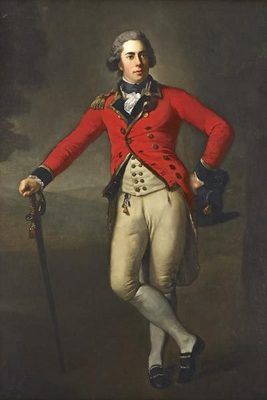
The next person to have a major impact on the Parthenon was Lord Elgin, a British statesman and ambassador to Constantinople in 1801, who had obtained permission from Turkish authorities to make drawings and plaster casts of the marvelous sculptures and to “take away any pieces of stone with inscriptions or figures”. (Many pieces of sculpture shattered by the explosion still lay buried or half-buried on the Parthenon grounds.) Lord Elgin’s agents were not content for long in picking up broken pieces of sculpture. Soon they were prying pieces off the building and, later, using saws to remove the artwork in sizable chunks. In their defense, they would have been familiar with other destructive practices of the era. The Turks had used some of the Parthenon sculptures for target practice and had lopped the heads off a few figures within reach (likely Pericles among them). In addition, the Turks used whitewash to paint their buildings, which had sprung up all around the Parthenon. Marble, when burned, produces lime and lime mixed with water makes whitewash. It was a recipe that would result in the destruction of both broken and complete marble statuary in Athens and elsewhere.
Today the remains of the Parthenon, the bleached bones of what was once an architectural masterpiece for the ages, provide mute testimony to the glory that was ancient Greece. The artworks that once adorned the marble walls can be found, in bits and pieces still clinging to the remnants of the ancient temple or scattered amongst the world’s leading museums in Athens, London, Paris, Munich, Rome, Copenhagen, Vienna, etc. In at least one case a marble sculpture taken from the temple was broken apart and pieces of it can be found in three major cities. Greece has petitioned Britain numerous times seeking the return of the Parthenon marbles from London (which has almost 50% of the sculptures), maintaining that the Turks had no right to distribute them to anyone. Britain has refused, saying the collection was legally acquired from the Government then in power and they have no intention of returning anything. And there the matter rests.
Greek Coinage
Throughout history and throughout the world all sorts of things have been used for money… beads, shells, salt, amber, cocoa beans, jade, ivory, copper, silver, gold, pigs, oxen, feathers, tobacco and so on. Some of these were selected for portability, some for their decorative appeal, and others for their immediate availability as food. What all had in common is that, for some period of time, they were recognized by the society in which they were used as an acceptable medium of exchange and as a means of paying debt.
There were various occasions in the lives of the early Greeks when they were called upon to make payments. Perhaps someone in the family had deliberately or accidentally (it made no difference!) killed another person. In lieu of killing the offender, arrangements were frequently made to accept an appropriate payment as an alternative- hence the term “ blood money ”. Possibly a father had agreed (occasionally with her consent) to provide his daughter’s hand in marriage to a prospective husband. Naturally she was expected to come with an adequate dowry, and one she was entitled to get back with interest should the marriage not work out. (In earlier times, the dowry arrangements were reversed. Originally, it was a payment made to the father of the bride by the prospective groom in compensation for the loss of the daughter’s services. But times change!) There were also taxes to be paid, tribute that was expected, the need to fulfill religious obligations, opportunities to trade with foreign merchants – all demands which could be easily satisfied via a portable and widely-accepted currency.
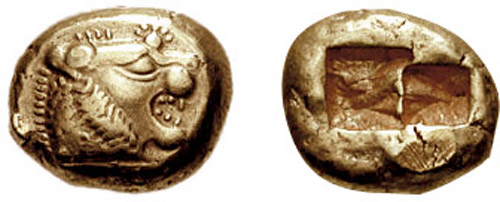
According to Herodotus, the “father of history”, it was the Lydians ( Lydia was located adjacent to Ionia in Western Asia Minor…present day Turkey) who were the first to invent and use silver and gold coinage (around 650 BC). From Lydia, its usage spread throughout the Greek realm and soon cities such as Aegina, Corinth, Rhodes and Athens were minting their own coins, according to their own standards.
The first generation of coins produced by the Lydians was made of electrum, a naturally-occurring pale yellow alloy of gold and silver, commonly called white gold. These were not perfectly circular like today’s coins. In fact, they looked somewhat like squashed kidney beans or flat pebbles with a stamped design on one side. (If you want to get a good approximation of the size and shape of early coins, make a short rope out of plasticene or putty and squeeze it between your thumb and forefinger. What you will be left with is a piece of material indented in the middle with irregular edges, thicker in some places than others. This made the coins difficult to stack.
Also, because the shapes and thickness of the coins varied it wasn’t long before some enterprising cheaters began to shave bits off the thicker parts of the coins. The minters responded by putting extensive designs on the coins and by impressing a raised circle around the rim. These only remotely resembled the handsome coins that eventually would be distributed by any Greek city-state of significant size, the coins proudly bearing the city’s emblem on one side and, perhaps, the head of its patron god or goddess on the other. It is enlightening to look at the evolution of coin production.
The early coin producer would take a valuable metal (gold, silver, copper), weigh out the appropriate amount for the coin he was minting, heat the metal until it was malleable enough to fit into an iron or bronze mold (die) and then hit the metal with a hammer to flatten it out. What resulted was a flattish, irregularly shaped object that could be used as money. Later minters or coin producers improved upon the process, engraving images in the die that could be transferred to the coin and, eventually, adding a second engraved die so images could be impressed unto the two sides of the coin with the same strike of the hammer.
The ever-competitive Greek city-states then did with coinage what they did in so many other cases. They improved it by adding beauty, minting coins during the 5th Century BC that have often been described as the most beautiful coins ever made. It was the Greek sense of aesthetics at work. Cities vied with each other to produce quality coinage that proudly carried imagery representative of the city far beyond its borders…the owl of Athens, the turtle of Aegina, the Pegasus of Corinth. The best instrument of propaganda until the invention of the printing press was probably the coin.
Sparta , which always seemed to be the exception to the standard Greek way of doing things, lived up to her reputation. As a society, they had concluded that the accumulation of wealth was not a Spartan value. But there was a need to pay debt among themselves, so they went with the iron spit (a slender, pointed iron rod used to hold meat over the fire) as their unit of currency. Prior to the introduction of coinage virtually all of Greece used these 3 ft (1m) lengths of iron as currency but Sparta was the only state to continue that usage while other states were using more precious metals. The cooking spit, which was about 3 ft. (1m) long, did have a long history as a unit of currency dating back to Homer. In fact the drachma coin seems to have derived its name from drax which means “handful” referring to the half-dozen iron spits one could hold in one hand.
The names of a couple of dozen coins are known and examples exist. Why they survived and were not melted down for their metal content is the result of where ancient Greeks tended to store their wealth- buried in the ground. A number of these hoards have been unearthed in modern times. Some of the more common denominations were as follows:
Obol = the smallest silver coin, equal to one cooking spit
6 obols = made up a drachma
1 stater = equaled two ( or sometimes three) drachmas
100 drachmas = 1 mina
60 minas = 1 talent
12 chalkoi = 1 obol (The chalkoi were made of copper.)
It is difficult to make a comparison between our currency today and the currency of ancient Greece. According to the historian Donald Kagan (The Peloponnesian War, page 61) one talent was the cost to build one warship of the trireme class. It was also the cost of paying the crew of that warship for a month (approximately 200 bodies). The published accounts of the Parthenon construction project (which were engraved in stone and put out in the agora for everyone to see) said the temple cost 469 talents. (A talent represented 57 lb (26 kg.) of silver. An ordinary clay pot sold for one obol. A labourer working at the time of Pericles could expect to earn 2-3 obols per day while an artisan or specialized tradesman such as a stonemason earned twice that. One could buy an upper-middle-class house for about 3000 drachmas or ½ talent. Then, as now, people in the entertainment business made disproportionately more than anyone else. The famous 4th Century actor Polus is reputed to have received one talent for only two performances.
Usually Greeks carried coins in their mouths since their clothing lacked pockets. When someone died they were buried with a couple of coins in their mouth to pay the ferryman Charon their passage across the river Styx to the underworld.
Daily Life
Overview
Daily life in the golden age of Greece varied, as it does today, according to economic status as well as by other factors such as war and even the type of government that was in place. The best way to get an appreciation of this is to look at a few specific examples and from these draw some general conclusions.
The life of a well-to-do young man growing up in Athens at the time of Pericles:
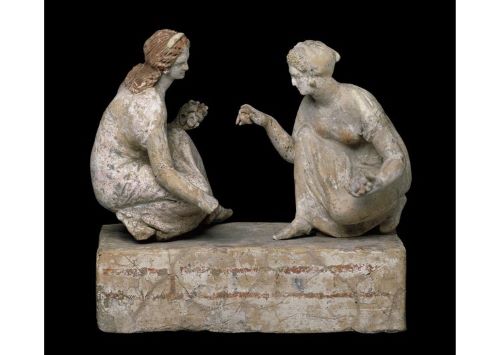
The advantage of being born a boy rather than a girl became apparent right at birth. It was considered very important to have a male heir, someone who could carry on the family line and name, who would care for his father in his old age and carry out the religious obligations that would ensure his well-being in the afterlife. The father decided whether his new born son should be allowed to live or whether he should simply be abandoned, put outside in a clay pot that would serve as his coffin. If he was kept, and most boys were except in times of siege or great economic hardship, he was given a name and became a part of the community. From that point on the father had no right to get rid of the baby. (Newborn girls did not fare as well, ancient sources noting that ‘a great number’ were exposed and left to die.)
The father also decided how the child would be raised and educated, some favoring home schooling and others bringing in tutors to educate them. (Alexander, the Great’s father King Philip brought in Aristotle to serve as teacher and mentor to the young Alexander.) Children grew up playing with a variety of toys ( rattles, balls, miniature chariots, wooden boats, clay houses; animal figures- pigs, goats, etc.) as well as perhaps a small number of pets- dogs, ducks, mice and, even, insects.
Formal education covered the usual 3 R’s ( reading, w riting and a rithmetic) as well as physical education and music. For the ancient Greeks, music was considered to have great importance in a proper education curriculum and students learned both to sing and to play various instruments. The school master and the music teacher conducted lessons in their own homes, not in state constructed schools. Although the state valued and took an interest in education, carrying out the instruction was a matter of private initiative. The works of Homer were an important part of the course of studies serving an a source of inspiration for lessons dealing with matters of a moral or religious nature. Homer was perceived as a guide for a proper life while the writings of Hesiod and Solon were considered of secondary importance.
By the age of eighteen the young Athenian was ready for military service. Prior to this, from roughly the age of twelve, he would have had considerable exposure to physical training participating in a range of activities- running, wrestling, jumping, discus and javelin. Of course many of the skills learned in these sporting endeavors would prove to be useful in time of war.
The life of a youth growing up in Sparta in the same era:
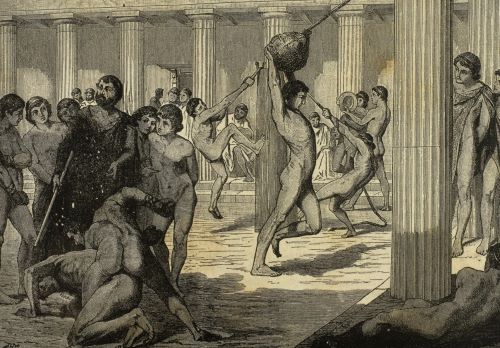
The Spartans didn’t write much. They had an aversion to writing literature and brevity of speech was considered to be a desirable trait so we have had to look at their society through the eyes of others. Four ancient sources- Herodotus, Thucydides, Xenophon and Plutarch provide much of the information about this much-admired and often-feared society. A key attribute of the Spartan way of life was austerity which extended to their homes, possessions, clothing and the food they ate. Only those who had died in battle or in childbirth were allowed to have tombstones and these provided limited information. There were also modest grave offerings.
As the historian Thucydides noted, “If, for example, Sparta were to be deserted and only the temples and the foundations of buildings remained, I imagine that people in the distant future would seriously doubt that Sparta’s power ever approached its fame.” Today we know the names of 20,000 Athenians and only a scattering of Spartan names and in the minds of many the story of ancient Greece is essentially the story of Athens. But in its heyday Sparta was the most powerful state in the Greek world, three times larger than the Athenian state and with its share of wealthy individuals. And it controlled its citizens literally from the cradle to the grave.
It began at birth. It was the state, not the father as in other Greek city-states, who determined whether a newborn male should live or die. If the baby appeared to be healthy and vigorous he would be kept; if not, he would be abandoned and left to die. Sparta was a military state, virtually always at war, and it needed a good supply of robust babies that could be trained to unquestioningly protect the interests of the state. The child, once accepted by Spartan officials, was raised at home until he reached the age of seven. At that point he left home and entered state schools to be trained to obey and serve in preparation for a life of military service that would last until he was sixty.
The Spartan student curriculum developed only basic skills in reading and writing. The emphasis was on content that would be useful in a military career- survival training, how to endure hardship, overcome obstacles and fend for yourself in hostile territory. Spartan youth went barefoot, they wore a single cloak in all kinds of weather and they were fed sparingly. They were encouraged to supplement their rations by stealing food and then whipped if they were caught in the process. The whip, in fact, played an important role in their upbringing.
By twenty, the Spartan youth had reached adulthood. At this stage he joined a “dining group” of his military peers. He ate all his meals with that group, bonding and developing a sense of camaraderie essential for hoplite warfare where all relied on each other. Sometime in the course of the next decade he would marry and live, not at home, but with his military messmates until he had reached the age of thirty.
Spartan girls enjoyed more freedom than their Greek counterparts in other states. They were educated by the state and their primary mission was to have children, particularly young soldiers-in-waiting. To that end they were well-nourished and encouraged to exercise, participating in a range of sports activities. Spartan women were also allowed to inherit and own property.
Greek Art and Architecture
Overview
Modern perspectives on what constitutes art and our clear distinctions between artists and craftspeople differ from the practice in ancient Greece. The Greeks did not have muses charged with responsibility for art and sculpture as they did for literature, music and dance. Indeed they did not have a word for “art” in their language using the word tekhne which translates as “craft”. Sculpture, pottery, metalwork and the creation of frescoes, mosaics and wall paintings fell into the realm of tekhne.
This attitude was often reflected in Greek wage scales and we see in accounting records where the architect of a major temple and a stonemason working on the same structure received essentially equivalent wages. That is not to say that their craftsmen weren’t held in high regard and that there wasn’t a generally recognized distinction between journeymen artisans and those whose skills had earned them greater prestige and esteem. Alexander, the Great insisted that busts of him be executed only by the renowned sculptor Lycippus and that paintings of him (e.g. Alexander, with thunderbolt) be done by the equally-famous Apelles.
Greeks with aristocratic roots looked upon any kind of manual labour with distaste. That certainly included sculpture, pottery and metalwork. Aristotle, enlightened in many ways, wrote that the title of “citizen” should be withheld from all those who earned their living with their hands, that it wasn’t possible to practice the civic virtues as a salaried worker. Others who expressed a similar view included Plato and Xenophon (but not Socrates who saw merit in honest labour and who practiced what he preached.)
The law-giver Solon notes that no well-bred young man could possibly want to be a sculptor and the pejorative word banausos was used to designate workers in at least some of the craft areas. This Athenian attitude, in a city admired for its art and beauty, is paradoxical and was not universal throughout ancient Greece. In many cities, particularly those with an industrial or commercial focus, the word cheironax was used to denote “master craftsmen” and these people were accorded honour and respect.
In the three sections which follow on architecture, sculpture and pottery the text is limited to the period extending from the Dark Age to Hellenistic times. Cycladic, Minoan and Mycenaean achievements in those areas are not covered.
Modern perspectives on what constitutes art and our clear distinctions between artists and craftspeople differ from the practice in ancient Greece. The Greeks did not have muses charged with responsibility for art and sculpture as they did for literature, music and dance. Indeed they did not have a word for “art” in their language using the word tekhne which translates as “craft”. Sculpture, pottery, metalwork and the creation of frescoes, mosaics and wall paintings fell into the realm of tekhne.
This attitude was often reflected in Greek wage scales and we see in accounting records where the architect of a major temple and a stonemason working on the same structure received essentially equivalent wages. That is not to say that their craftsmen weren’t held in high regard and that there wasn’t a generally recognized distinction between journeymen artisans and those whose skills had earned them greater prestige and esteem. Alexander, the Great insisted that busts of him be executed only by the renowned sculptor Lycippus and that paintings of him (e.g. Alexander, with thunderbolt) be done by the equally-famous Apelles.
Greeks with aristocratic roots looked upon any kind of manual labour with distaste. That certainly included sculpture, pottery and metalwork. Aristotle, enlightened in many ways, wrote that the title of “citizen” should be withheld from all those who earned their living with their hands, that it wasn’t possible to practice the civic virtues as a salaried worker. Others who expressed a similar view included Plato and Xenophon (but not Socrates who saw merit in honest labour and who practiced what he preached.)
The law-giver Solon notes that no well-bred young man could possibly want to be a sculptor and the pejorative word banausos was used to designate workers in at least some of the craft areas. This Athenian attitude, in a city admired for its art and beauty, is paradoxical and was not universal throughout ancient Greece. In many cities, particularly those with an industrial or commercial focus, the word cheironax was used to denote “master craftsmen” and these people were accorded honour and respect.
Fortifications
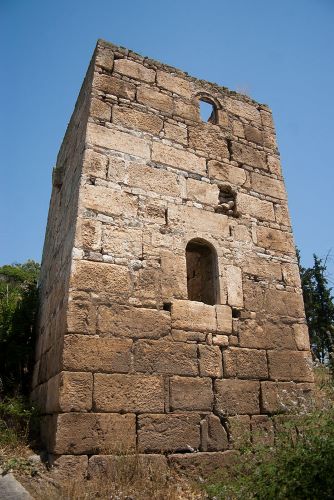
As a general rule, every city was fortified with the extent and nature of the fortifications being influenced by natural landscape features. It was only a state such as Sparta, whose reputation preceded it, or a poorer community with little worth stealing that didn’t have substantial city walls. The main defensive structure was an encircling wall whose length was interrupted at strategic intervals by round or square towers. The thickness of the wall and the height, shape and placement of towers were important considerations. Usually the walls and towers were built of limestone. Vertical slits in the tower walls allowed archers to fire their arrows down upon attackers.
Theatres
In the fourth century B.C. cities began to build stone theatres. In fact one of the most characteristic buildings found in any ancient Greek city of any importance was a quality theatre. Audiences in Athens who had attended presentations by the masters of the Greek stage- Sophocles, Aeschylus and Euripides- had been seated on wooden benches lining the south slope of the Acropolis. Their descendants had a better environment. The typical Greek theatre was built into the slope of a hillside which provided support for the curving banks of stone seats that faced the stage. Most patrons brought their own seat cushions to these open air structures since watching plays during a festival period was somewhat of an endurance contest.
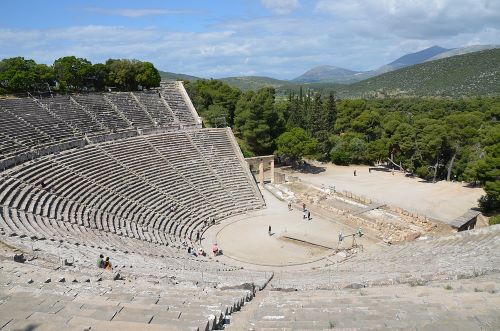
The theatre at Epidaurus is still remarkably well-preserved and plays are regularly presented there. The acoustics are astounding; even a whisper on the stage can be heard in the back row of seats- a tribute to the famous architect Polykleitos, the Younger. Its fifty-five rows of seats could accommodate up to 12,000 spectators, considerably more than could fit into an average city theatre which, typically, could handle an audience of 5000.
Temples
From early times, the open-air altar played an important role in worship. The outdoor aspect was a practical consideration. Sacrificing 100 head of oxen, as happened on festive occasions such as at the Olympic Games, with its inevitable blood and smoke, was an activity best carried out in the open air. But, influenced by the East- particularly, Egypt- temples began to be seen as appropriate structures to house the image of a deity. That usage dictated a level of quality befitting a divine being. Accordingly, the Greeks looked to their predecessors and to their neighbours for ideas on suitable designs for a temple. From their Mycenaean ancestors they took the idea of an architectural footprint based on the rectangular megaron or “great hall”- a room with a frontal porch supported by columns. From the Egyptians they borrowed the concept of monumentality and a range of design elements and ornaments such as fluted columns, palmettes, spirals, rosettes, lotus plant imagery, etc.
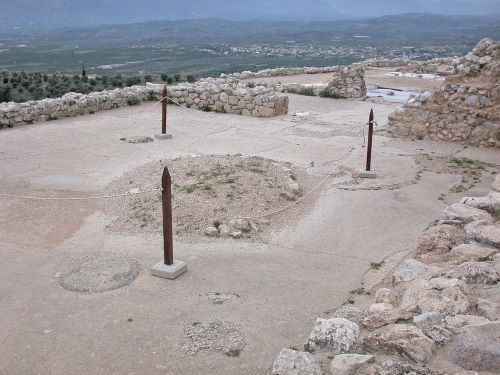
The first Greek temples were a far cry from a classical masterpiece such as the Parthenon. During the Bronze Age it seems that no temples were built and there is uncertainty as to when they began to be built. It happened during the Dark Age but surviving examples, according to A.W. Lawrence are “few in number and of deplorable quality.” The construction materials were mud brick for the walls with high-pitched roofs made of timber. Greek builders were not satisfied for long with this model and they gradually made their way to stone construction.
During the 7th century the Greek “Orders of Architecture” began its evolution. Few people today are not familiar with the notion that there are Doric, Ionic and Corinthian styles. Many can even pick out the different styles in modern examples in their cities for these became widely admired and copied throughout the world.
All three styles are built upon a single construction system- the post and lintel- where a horizontal block of stone (the lintel) is laid across two supports (posts or columns). It was a simple system which imposed some limitations on the architects but it assured an appropriate result. An inspired architect might produce a Parthenon but a less gifted individual would at least produce a temple adequate for religious worship. Instead of seeking innovation in other systems and styles, Greek architects sought refinement and perfection in the system that they had chosen. They laid down a framework of rules which spelled out how to address composition and proportion. All of the elements and components had a specified form and function. Tey working within that formula Greek architects were able to produce a range of distinctive temples including some that made the List of Wonders of the ancient world.
The Parthenon is considered to be the greatest of the Doric temples, the ultimate achievement of architectural perfection in this style.
Sculpture
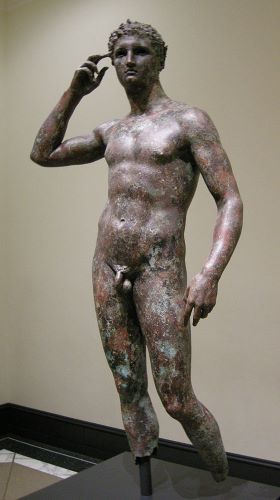
Fortunately the artistic output of the ancient Greeks was extensive because most of it has now been lost. But enough remains in originals, fragments and copies that we are able to appreciate not only the volume of what was produced but also its quality. Life-sized or larger stone sculptures were not produced in Greece before 650 B.C. It was around that time that the Egyptian pharaoh Psammetichos allowed two groups of Greeks (Ionians and Carians) to settle along the banks of the Nile River. The Greeks learned the art of large stone carving from the Egyptians although they used the limestone and marble available in Greece, not the harder porphyry and granodiorite favoured by the Egyptians. The Egyptian “look and feel” was initially adopted by the Greeks but they were not content for long to simply produce sculptures in a style that had served the East for many generations. Within a couple of centuries they had evolved their distinctive Greek approach and abandoned the Egyptian formula.
The Greeks used a variety of materials for their large sculptures: limestone, marble (which soon became the stone of choice- particularly Parian marble), wood, bronze, terra cotta, chryselephantine (a combination of gold and ivory) and, even, iron. The only material which has survived in any quantity is stone; the others were too precious or too fragile to survive the 25 centuries or so interval between the time of production and the present.
The stone sculptures of the ancient Greeks would not appear familiar to us today. Shortly after the pieces were carved they were painted either completely or in part. That was consistent with Egyptian practice and it may have made sense in the bright sunlight of Greece. The statues also were outfitted with a range of accessories that would have made them resemble figures in a modern wax museum. Hair and eyelashes were fashioned out of metal. Eyes were inset and were made of glass, ivory or coloured stones. Female figures were often outfitted with earrings and necklaces. Athletes would have been shown wearing the victor’s wreath while warriors would be equipped with spears, shields and swords. Horses would have worn bridles and reins. If you look closely you can often see the holes for attachment of these accessories.
The head and limbs of Greek stone statues were often made separately and attached to the statue torso using dowels and tenons of metal and stone. Occasionally, cement was used to fasten on smaller pieces.
The huge statues of deities such as Athena and Zeus that were made of gold and ivory- chryselephantine (chrys = gold; elephantine =ivory)- deserve particular mention. They were huge works of art by any standards and remind us that the primary purpose of Greek sculptures, at least initially, was religious. They were the temple centerpieces and their production cost rivaled or exceeded that of the temple which housed them. A large wooden core made up the body of the statue to which sheets of beaten gold (for the clothing) and ivory (for the flesh) was added. The statue then was always the target in times of war or economic uncertainty.
The victor in the various athletic festivals or his supporters often paid for a statue of the athlete, erected either at the festival site or in his hometown. In the case of the Spartan woman Kyniska who won the four-horse chariot race at the Olympics in 396 B.C. she had a bronze commemorative statue erected at Olympia. (Unfortunately only the fractured base and a part of the inscription text remains. As was often the case with large bronze sculptures it was likely melted down for the valuable metal.) The famous bronze charioteer from Delphi is one votive offering that did survive. In addition, statues were often commissioned in remembrance of an historical event. (e.g. the equally-famous Tyrannicides statues which commemorated the assassination of the tyrant Hipparchos) The need for private grave markers and memorials also contributed to the on-going demand for statues.
The evolution of Greek sculpture is a journey from the realm of the rigid and stylized towards the ideal of naturalism. Early figures resemble a mathematical formula executed in a hard and unyielding medium. It is as if the sculptures have emerged rigid from a frozen block of material. Late figures are far more relaxed and natural to the extent that one could easily imagine the statue taking a breath.
In the world of the ancient Greeks there was a very close relationship between sculpture and architecture. Both temples and sculptures were created in order to honour the gods and the sculptures were not just an embellishment of the temple; together they combined to form an integrated and harmonious whole. The Parthenon is a good example and modern Greeks have long made the point that the so-called Elgin marbles, now a centerpiece of the British Museum, were an inseparable part of the Parthenon and cry out to be reunited with the building.
Pottery
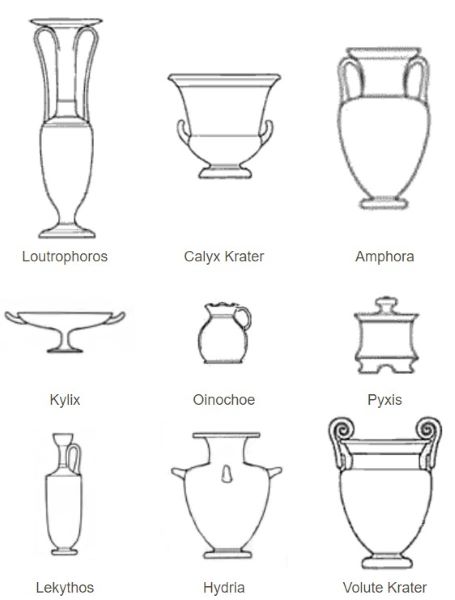
The art of making pottery was first developed in the Neolithic Period. Coils of clay were used to build up the body of the vase. The artisan would dig up the material from clay beds and get rid of impurities. This was done by a process called levigation– mixing the clay with water so that heavier particles sink to the bottom and lighter materials float on top. The clay might have to be washed several times before there was a sufficient quantity of suitable clay that could then be kneaded by the artisan into ropes suitable for coiling.
Around 1800 B.C. the potter’s wheel was introduced. As the wheel spun, the clay would be pulled up by the fingers into the required shape. Large pots were done in several sections and the sections joined together by slip (a mixture of clay and water). The joins on the outside of the vessel are usually not noticeable but they can often be seen on the inside of the pot. The foot, the spout and the handles were also produced separately. Like the body sections, the clay was allowed to dry until it had achieved the consistency of leather at which point they were joined with the slip. The parts are so well integrated in a quality Greek vase that nothing appears to be simply “stuck on”. If the vase was to be decorated (and common or coarse wares were not), it was done at this point.
There are dozens of types and shapes of pottery vessels ranging in size from small perfume flasks to containers which served as large tubs and coffins. Depending on the era and location of production the pottery exhibits a wide range of decoration.
The chronology of Greek pottery has been well-established. Even to the untrained eye, there is a very distinctive difference between a proto-geometric vase from Athens produced in the 10 th century B.C. and one produced in the same location in the 5 th century B.C. Here we will just deal with the Black-Figure and Red-Figure pottery for which Athens became justly famous, even in antiquity.
Early in the 7 th century B.C. it was Corinth which was the political and commercial powerhouse of ancient Greece. Their leader was the tyrant Cypselus and under his leadership Corinth became the pottery export center of the Mediterranean. Corinthian potters invented a new technique of “painting” the vases which became known as “Black-Figure pottery”. It was a widely-sought commodity and in response to demand Corinth stepped up production. In the process, however, the quality fell and buyers clamoured for a better product. It was not long before the potters of Athens had mastered the Corinthian techniques. They also had the advantage of having ample clay beds with superior-quality clay which, when fired, turned an attractive pinkish-red. Soon their wares were being distributed all over the Aegean and even into North Africa, Asia, France, Spain and Crimea. The export of vases enabled Greece, a country with few exports, to be able to pay for the importation of badly-needed goods.
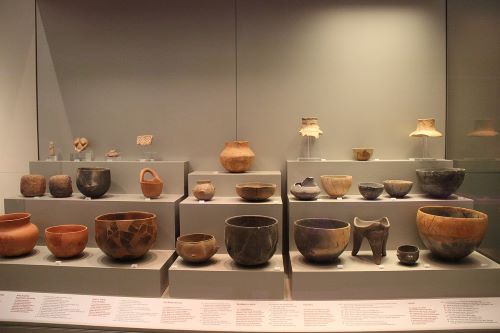
As was the case with Greek architecture and Greek sculpture, the Athenians excelled in attaining high standards for their ceramics. Functionality, guided by aesthetics and coupled with a penchant for quality control was the key. But it was the decoration that made Athenian pottery so renowned.
It is only in modern times that scholars have solved the mystery of what the black material is, in Black-Figure pottery. It comes from a highly purified clay containing iron oxides which, when fired in a particular three-step sequence, turns black. (In the first firing stage air is provided, in the second stage access to air is reduced and smoke is added and in the third stage air is one again allowed into the kiln.)
Towards the end of the 6 th century B.C. the black-figure decorative approach was reversed. Previously the artist positioned his figures in black silhouette against the red clay colour of the pot. That meant that if he wanted to show details within the black figure the artist had to incise those i.e. scratch the design details into the black. Now, in the red-figure scheme, the figures are left in the natural colours of the clay. The artist then has the options f painting, doing a line drawing or incising. That enabled a much greater level of detail, allowed figures to be shown in the course of normal movements and permitted better efforts at achieving perspective. During the transition period from black-figure to red-figure, a number of vases were painting using both techniques to illustrate the same scene. Some of these have survived and clearly demonstrate the advantages of the red-figure technique although black-figure paintings by masters such as Exekias remain superb examples of Greek imagery at its finest.
The majority of Greek vases shown in museums today are black-figure or red-figure but, in ancient times, there was significant production of all-black pots, devoid of any kind of figuring. There was also white-ground pottery where a slip of white clay was applied to a vase to act as a background for a line drawing. The white ground was fragile however and unsuitable for wares that were going to be handled a lot. It was however suitable for pottery, particularly the lekythos, used to hold ointments and oils intended for the use of the dead. These would be deposited in graves and so weren’t subjected to the handling of other kinds of pots. Scenes of mourning women seated at a tomb were typical for this kind of pottery.
Mythology
People sometimes use the words myth, legend, folktale and fable as though they were interchangeable, but are they? The dictionary definition of each is as follows:
Myth … a usually traditional story of ostensibly historical events that serves to unfold part of the world view of a people or explain a practice, belief or natural phenomenon
Legend … a story coming down from the past, especially one regarded as historical although not verifiable
Folktale … a characteristically anonymous, timeless and placeless tale circulated orally among a people
Fable … a narration intended to enforce a useful truth especially one in which animals speak and act like human beings.
In reviewing these definitions it is easy to see why, in casual conversations, these terms are used in an inexact fashion. A review of some of the secondary definitions adds to the confusion. A secondary definition of legend reads “a popular myth of recent origin”. Even mythology specialists openly differ on descriptions and definitions of these terms. Finding scholars who agree and disagree on the following observations should not be difficult.
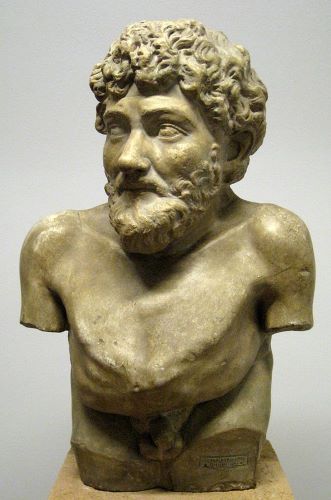
The purpose of a fable is to teach some moral or principle of behavior. Aesop’s fables provide a range of such lessons (e.g. The Hare and the Tortoise = slow and steady wins the race). Fables are clearly fictitious and often contain elements of the supernatural but no mature reader would conclude that long ago these things really happened. But few would argue that fables have both entertained and enlightened children of all ages and cultures for many centuries.
Folktales also fall into the realm of fiction. They are not based on a particular individual or incident. Animals are often involved and they often act like humans.
Legends are very specific and they focus on a particular individual or incident e.g. The Legend of Paul Bunyan or the Legend of Sleepy Hollow. These stories get handed down from generation to generation but lack hard evidence to back them up. And then, there is myth.
There have been a lot of academic arguments over the years on what constitutes a myth. Most cultures have them and although the content varies, the characteristics are roughly the same. Firstly, a myth is the story of a people passed down through the generations and not traceable to a particular author. Secondly, there is often a kernel of truth in a myth if you look at it searchingly. Thirdly, there are often variations in the story. (A string of storytellers in different locations over the years tend to add elements that often feature their locale.) Fourthly, “the faithful” believe the myth to be true and an important part of their belief system. Fifthly, a supernatural entity almost always plays a role. Sixthly, the myth offers an answer for phenomena or events in the absence of more plausible explanations, e.g. how mankind came into existence, what causes lighting, the changing of the seasons. Myths also often break the laws of nature- Odysseus visits the Underworld, Achilles can’t be injured except in the heel, everything Midas touches turns into gold.
Classical mythology deals with the relationship between mankind and the gods and goddesses who inhabit the domain of the supernatural. The historian Michael Grant says that “The myths told by the Greeks and Romans are as important as history for our understanding of what these people, ancestors of our own civilization, believed and thought and felt, and expressed in writing and visual art. For their mythologies were inextricably intertwined, to an extent far beyond anything in our experience, with the whole fabric of their public and private lives.” (Grant- Myths of the Greeks and Romans)
It must be remembered that the Greeks were an intensely religious people and to them their world was filled with a host of benevolent and malevolent beings, all of whom could have an impact on their well-being. It was essential to appease and placate these restive, capricious spirits and to enlist the support of deities who would be willing to assist the supplicant in getting a plentiful crop, carrying out a military assignment or undertaking some arduous task. Naturally enough, lack of success in any of these initiatives could be attributed to a god who happened to be in a cantankerous mood or simply the result of a failure to make an offering in the prescribed manner.
Science was in its infancy and had yet to come up with alternative theories to explain such things as the plague, earthquakes or the changing of the seasons. If you lived in ancient Greece and believed in the existence of the deities, Apollo, Demeter and Poseidon, which of the following would seem the more logical explanation?
- The plague is caused by animals (bacteria) too small to be seen by the human eye or the plague is caused by Apollo shooting arrows into people who had offended him;
- Earthquakes are caused by changes between the earth’s tectonic plates or earthquakes happen when Poseidon angrily drives his trident into the ground.
- The change in seasons is caused by the earth tilting on its axis or Demeter is mourning until her daughter Persephone returns from the Underworld.
Greek myths, as we know them, came to us from the lips of a small number of gifted and influential poets. The stories which they have passed on to us had been evolving over generations, had been tested in the face of critical audiences and were likely written and revised numerous times until they were in their present form. Carefully examined, they reveal a lot of information about the early Greeks, compelling information to those who are their intellectual, political and artistic heirs. We owe a debt of thanks, first and foremost, to Homer, the greatest epic poet, followed closely by Hesiod whose Theogony was a “who’s who” guide to the Greek pantheon. Pindar, (some say the greatest lyric poet ever), filled his victory odes with mythological references. The three Greek playwrights of tragedy- Aeschylus, Sophocles and Euripides wrote almost exclusively on mythological subjects (One of them was quick to acknowledge that he and his contemporaries “all dine on crumbs from the great table of Homer”.) Herodotus, Aristophanes, Pausanias and Apollodorus round out the list of the ten men who collectively wove the fabric that essentially is Greek mythology.
Classical mythology has become an integral part of our lives although few today believe in the pantheon of gods and goddesses created and sustained by the fertile imagination of the ancient Greeks. Wander into any art gallery or museum and you will see evidence of the influence of mythology on the choice of subjects. Greek painters and sculptors went to the vast warehouse of mythology to draw inspiration for countless thousands of works; now we draw inspiration from their masterpieces. Greek playwrights relied on the tragedies of mythology to entertain audiences of their generation and subsequent ones up to the present day,
Hollywood movies, comic books, television programs and various genres of literature have peopled their stories with characters from mythology or derivatives from them. The world of advertising has also borrowed freely from mythology using the names and attributes of gods and goddesses to sell their products and services. Look at the telephone directory to see Atlas, a symbol of strength, used to sell steel and tires; Apollo, for a music store; Aphrodite, spa and beauty services; Athena, intellectual property; Hermes, messenger services; Dionysus, wine-making supplies. The world of classical mythology lives on in the 21 st century.
Theatre
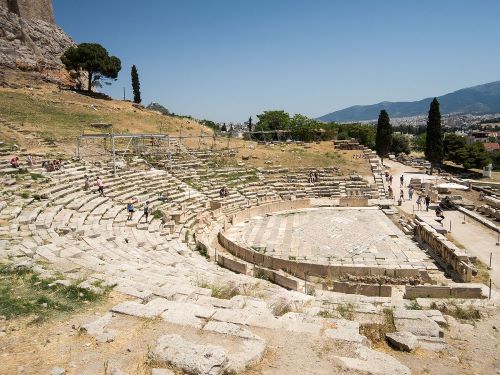
The fact that every Greek city of any size had a theatre and sometimes more than one (Attica had several) is an indication of their importance to the community. The theatre offered an experience which brought together elements of myth, ritual, religion, dance, music and literature. It provided a forum for the exchange of ideas, an opportunity to escape from the sometimes harsh realities of everyday life and an occasion to see and be seen. It also had some of the hallmarks of an endurance contest since someone who attended a full festival of plays, and many did, listened to perhaps 20,000 lines of poetry while seated on hard wooden or stone benches.
Greek theatre had its origins in religious ritual. The god Dionysus, often associated in modern minds only with wine and revelry, was also an agrarian deity, with aspects reminiscent of the Egyptian god, Osiris. Like Osiris, he was twice-born, the second time from the thigh of Zeus, father of gods and men. Celebrations linked to planting and harvesting began in ancient times right on the floor where the grain would be separated from its stalk. It was an opportunity to exhibit the Greek love of dance and music, to give thanks for a bountiful harvest and perhaps to partake of the beverage with which Dionysus is most associated. Some of the nomenclature used in the theatre clearly had its origins on the threshing floor.
Greek plays were presented within the context of a Dionysian festival structured along the lines of athletic festivals held at Olympia, Nemea and Delphi, and were of a similar duration. Civic authorities were responsible for organizing the event and it was presided over by the priest of Dionysus. The play itself took place in the open air and, most often, at the base of a sloping hillside which provided each tier of seats with an unimpeded view. In earlier times plain, wooden benches were simply aligned in a semi-circular fashion surrounding the circular orchestra space, at the centre of which stood the altar of Dionysus. In later years, the theatre architecture became much more sophisticated culminating in structures such as the magnificent theatre of Epidaurus, whose acoustics (and those of other Greek theatres) was so much admired. Even a whisper on stage can be clearly heard in the highest row of seats. But it was not in the splendour of these stone theatres however that rapt audiences were first enthralled by the plays of Aeschylus, Sophocles and Euripides, These theatres weren’t built until much later.
In Athens, the Greater Dionysia festival took place in March (There were several other festivals of Dionysus throughout the year.), celebrating the end of winter and the beginning of spring. During this festival four days of plays were presented, each with no breaks or intermissions. The first day was devoted to comedies submitted by five different playwrights; the next three days to tragedies- with a daily satyr play thrown in for light relief. The winners got prizes- a plain ivy wreath- as well as undisclosed honoraria.
Seating was on a first-come, first-serve basis, although there was a centre row block of seats reserved for V.I.P’s, including the priests of Dionysus. In the early days admission was free. Later on, there was an admission charge (and some bronze tickets have survived), although that was waived for the poor. There were some large theatres capable of accommodating 15,000 or so spectators but most theatres were considerably smaller than that. Lines were delivered on stage, in the orchestra area, although most action (murders and such) took place off-stage, out of sight of the audience. There were very few props, scenery or backdrops; audiences were expected to use their imagination.
In Greek plays, there were no actresses; all roles were played by men wearing masks made of wood or cork. These were carved and painted to depict exaggerated expressions of anger, fear, despair, etc. and were switched as the themes of the play required. The masks may have helped in the projection of voices to the uppermost rows. The costuming, for the most part, was comprised of typical clothing although the colours may have been brighter than usual. Thick soles were sometimes worn to give the actors additional height. Comedy clothing was often padded and fitted, by the end of the 5 th century B.C. with huge, red leather phalluses, suggestive of the ribald nature of some comedies.
Mythology supplied the content for the tragedy plays which were perhaps more akin to operas than modern plays. Although works of art and some surviving artifacts give us an idea of the range of ancient Greek musical instruments, there is no consensus on how the music sounded. Imagine staging Phantom of the Opera two millennia from now with the lyrics spoken not sung and lacking music and choreography to get a sense of the difficulty of really understanding and appreciating the impact of these ancient performances.
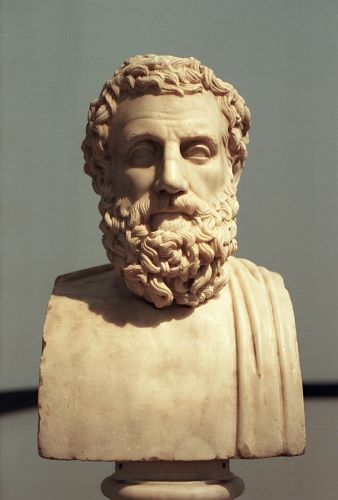
Teachers of drama talk about the four greatest playwrights of all time; three are Greek and only Shakespeare belongs in their company. Aeschylus (525-456 B.C.) was the earliest and, some say, the greatest dramatic poet. He introduced the Second Actor transforming, in effect, monologue into dialogue and he reduced the size of the chorus, moving from an unwieldy 50 to a more manageable and numerically-desirable 12. When he was asked to write his epitaph he chose not to mention his glorious writing career but instead pointed out his presence and his contribution at the defining Battle of Marathon. Several of his plays survive, such as: The Persians, Prometheus Bound and The Oresteia.
Sophicles (496-406 B.C.) was a product of the Age of Pericles (they were close friends) and his career overlapped that of Aeschylus and Euripides. Aristotle considered him to be the best ever in his field. He introduced the Third Actor, an innovation which enlarged the scope and dramatic impact of the play. Surviving works include: Oedipus, the King and Antigone.
Euripides was a prolific playwright crafting 92 plays of which seventeen survive including Medea, The Trojan Women and The Children of Herakles. He found the chorus to be a distraction and minimized its role. He also introduced a new element ( the prologue) which provided the audience with a preview of what is about to happen. Success came to Euripides late in life and that may have made him somewhat introspective and antisocial.
Greek comedy is often difficult for us to fully appreciate based as it was on local events and incidents familiar primarily to the community. References that might have had Athenians rolling in the aisles leave most of us with a quizzical look. The stereotypes though are known to us- the crafty slave, the greedy entrepreneur, the lusty sailor, etc. Aristophanes, author of The Birds, The Frogs and The Clouds was from the Old Comedy Period (c.450 B.C.) and the titles of his plays reflect costumes that would have been worn by the chorus. No one escaped the acerbic wit of Aristophanes, especially politicians and philosophers, and there is little doubt that in modern times he would be charged with slander and libel. Even in those liberal times he did not always escape unscathed; his attacks on Athens while it was at war with Sparta provoked considerable anger.
Menander is the only representative of the New Comedy Period (c. 350 B.C.) with any surviving works to his credit. He can be considered as one of the major founders of modern comedy. He wrote more than 100 plays but only one complete play survives.
Originally published by the Canadian Museum of History, republished with permission for educational, non-commercial purposes.
